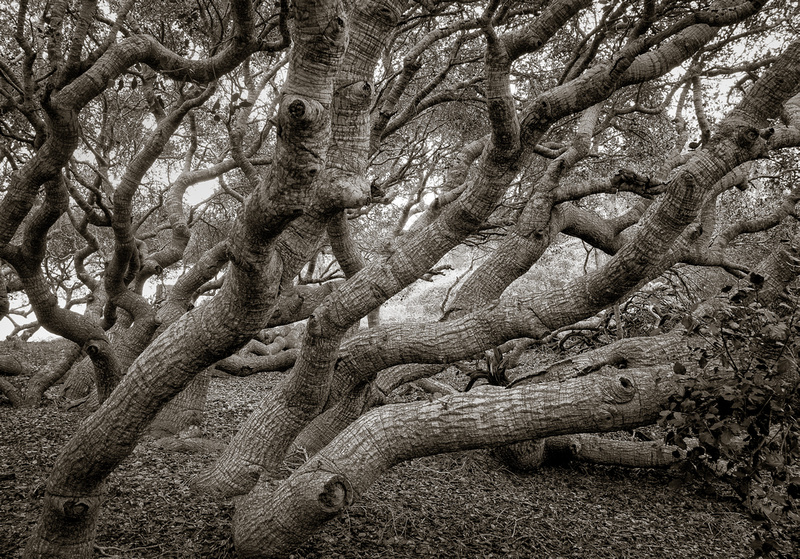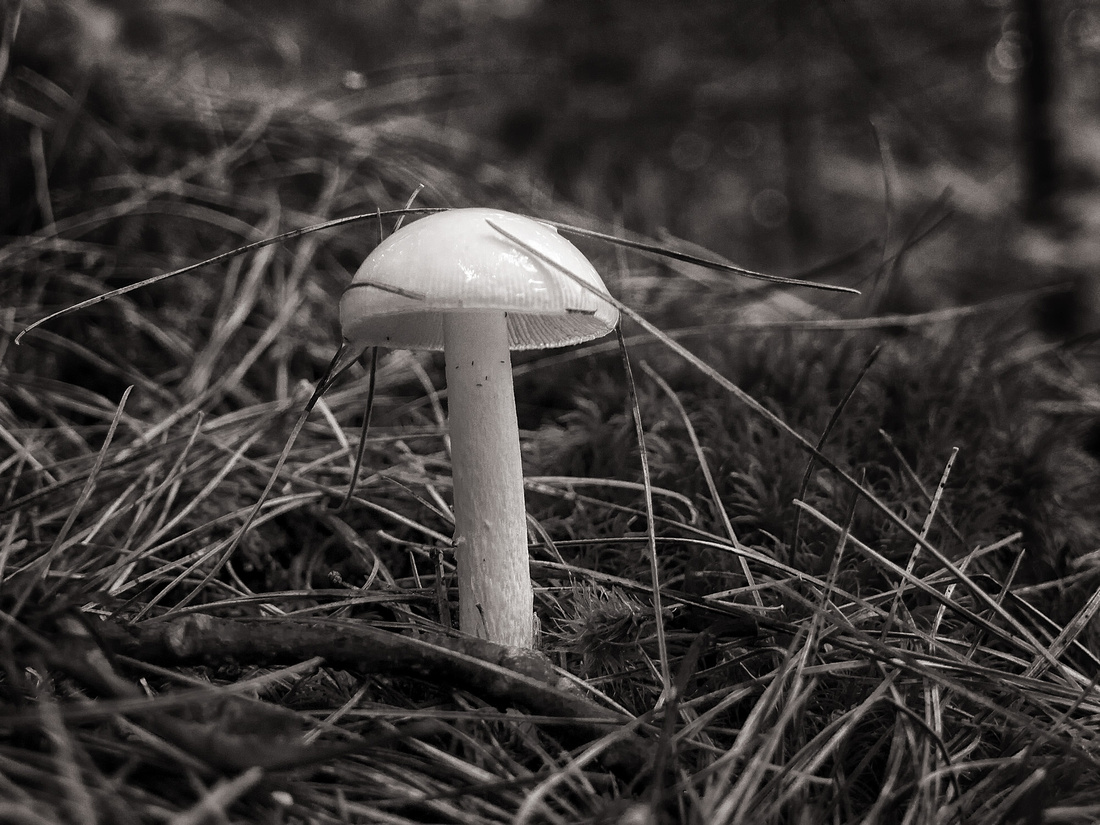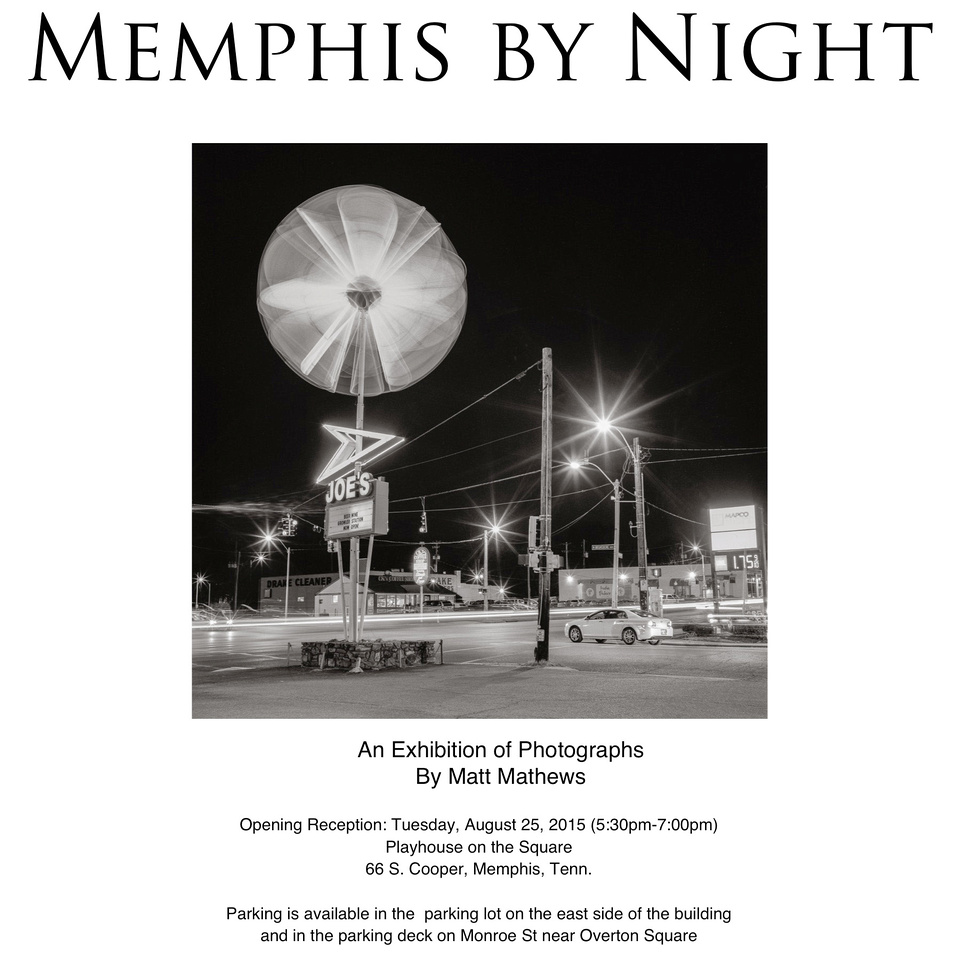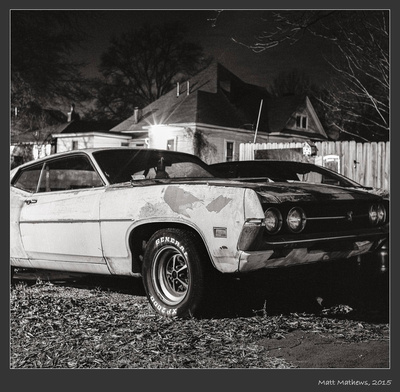
Ironwork, Harahan Bridge, Memphis, Tenn., 2019
When asked about what makes photographs "good," many photographers will say that they "must tell a story." The idea of pictures telling stories is a powerful one. It reached its zenith in the heyday of the "picture magazines" of the mid-twentieth century, Life and Look, for example. In these magazines, one found "photo essays," carefully sequenced series of photographs that aimed to move the viewer through a visual narrative and plot with a beginning, middle, and end. When done well, such photographic essays do indeed "tell a story," and they often do it better than words alone.
But I don’t think that all good photographs "tell a story." Some do, but not all. In fact, I have never found the metaphor of storytelling the most helpful one when it comes to photography. Instead, I prefer to think of my photographs and most photographs made by others as visual poems.
Poems are very different from stories. They are highly concentrated forms of expression that use an economy of means to convey complex meaning. Generally speaking, poems don’t emphasize moving the reader through a plot with character development, conflict, and resolution. Narrative movement through time is not at their center. They are more lyric than epic, often emphasizing the seemingly insignificant but telling detail present in an evanescent moment of life. And even when we string together a series of photographs, they are less like a story and more like an anthology of poems, bound together more loosely than a plot.
Poems are also different in that they rely more heavily on the evocative and suggestive, offering through their use of concentrated language a multiplicity of possible meanings. Hence, we see the poet’s predilection for metaphor and word play. What photographer Brassaï said of pictures holds equally true for poems, they should “suggest rather than insist."
But at bottom, the concentrated use of words and the evocative power of poetry are intimately connected to the importance on form, the rigorous organization of discrete elements into a coherent pattern in which the whole is greater than the sum of the parts. Form is the integrative arrangement of disparate elements that make possible beauty. In poetry, form is carried in meter, rhyme scheme, and word sound. These form the skeletal structure on which the flesh of metaphor and meaning hang. While all successful art embraces form there is an unusual intensification and surfacing of it in poetry. In the poem, form rises from the depths and floats on the surface to be more easily seen, heard, and felt.
Photography shares with poetry this intensification and surfacing of form in service of concentrated, evocative meaning. The form of photographs is carried in the symmetry and proportionality of the relationships between the elements included in the photographic frame. The artful use of lines, the deliberate placement of balancing tonalities across the frame, the repetition of shapes and their arrangement into patterns, for example, mirror the intensification and surfacing of form achieved in poetry through meter, rhyme scheme, and word sound. And as with poetry, such form brings harmony, order, and integration to the subject matter.
Photographers and poets also intensify form through a subtractive process. The poet whittles away the stalk of words until only a few are left, excluding all that are extraneous, so that what is important may be seen in a clear and concentrated way. And so it is with photographs. Good photographs are as much about what gets excluded as included in the frame. By excluding extraneous elements, form is rendered visible and powerful as it organizes the essential elements into a whole and completes the illusion of three dimensionality.
But form is not simply about good graphic design or composition. It’s about the soul. We crave form. It speaks to us. It answers to the deepest needs of the human heart.
In his thoughtful book, Beauty in Photography, Robert Adams writes "Why is Form beautiful? Because, I think, it helps us meet our worst fear, the suspicion that life may be chaos and that therefore our suffering is without meaning.”1 To encounter form, to elevate it in artwork, and to pursue it in creativity bring us into contact with a primordial truth; namely, that beneath the chaos and flux, beneath the apparent meaninglessness of so much of daily life, beneath tragedy, mortality, and seemingly senseless suffering is an underlying order to the universe. Form touches the coherence that binds all things together, including tragedy and suffering, and makes of all of it something meaningful.
Form reminds us that there is a place for us in the universe, and while it is not a place of ultimacy or painlessness, it is still a place of hospitality. There’s room for us in the cosmic scheme of things, and we sense that whatever powers weigh down upon us, however terrible and tragic, are not ultimate; we sense, instead, that the powers that uphold us are greater still. Perceiving form reassures us of the ultimate meaningfulness of life, that the world and our lives in it are no cosmic accident. It’s an inoculation against nihilism.
Nihilism, though it goes by many names, is among the greatest threats of modern life. It does not stop at denying meaning. It quickly replaces it with naked power, the cynical denial of all facts, and belligerent egoism.
In the end, form vindicates Dostoevsky’s idiot who announced that "beauty will save the world.”
And photographs, together with the other arts, can also announce this glorious fact.
———————————
1Robert Adams, Beauty in Photography (New York: Aperture Foundation, 1996) , p. 25.
]]>
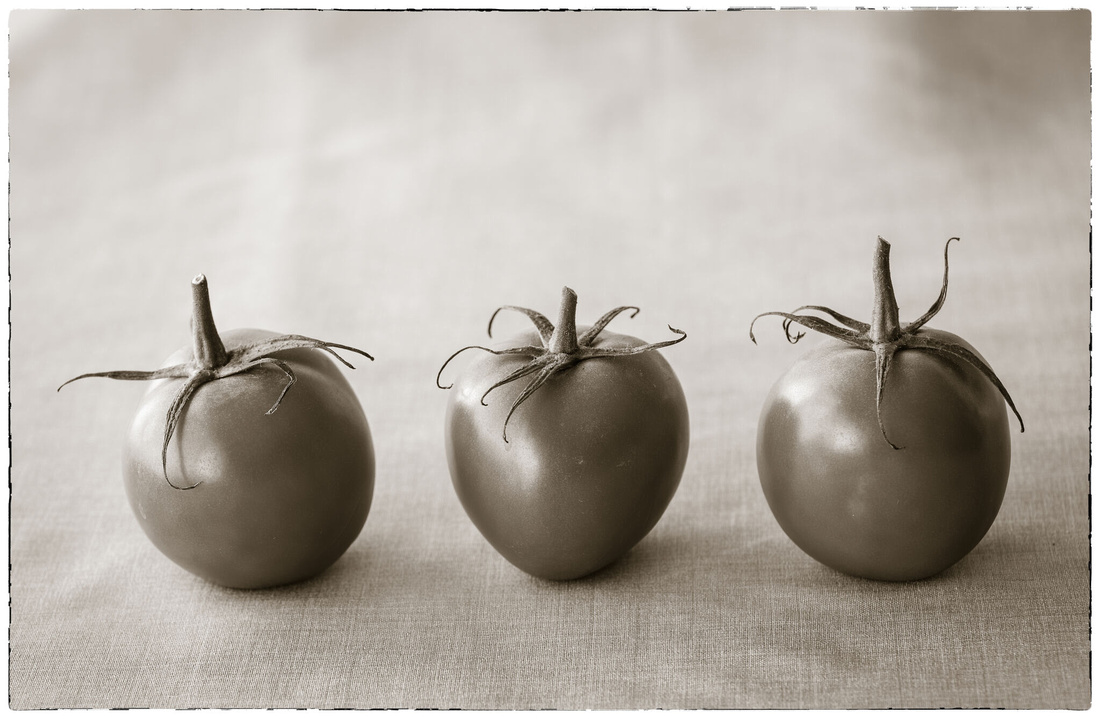
Three Tomatoes, 2019
In her provocative book, On Beauty and Being Just, Elaine Scarry explores the nature of beauty, aesthetic experiences, and their connection to the moral life. In this lucidly written little work, Scarry notes that when we experience something as beautiful, we impart to it a sense of “aliveness.”
In highlighting aliveness, Scarry is drawing attention to the way that we experience beautiful objects as having or taking on certain lifelike qualities that beckon us into a relationship with them. We experience them as generative realities rather than as static, inert things. Aliveness transforms an it into a thou (Martin Buber). Beautiful things call out to us, make a claim on us, asking us to acknowledge their inherent worth and moral goodness. We answer the call of beautiful things by imbuing them with sanctity and inviolability. Their fragility awaken in us an urge to protect and secure them. Down deep, we sense, even if only intuitively, that the wellbeing of beautiful objects and our own wellbeing are inseparable and mutually entailing.
When we confer aliveness on something, we are welcoming it, extending a kind of hospitality to it, allowing it to take up residence under the roof of our moral regard. This requires what philosopher Iris Murdoch calls “unselfing,” a decentered state of self-forgetfulness.
But something very curious accompanies this unselfing: intense pleasure. In granting aliveness, two things happen in the same moment: we are displaced as the measure of all things as the beautiful object is placed on an elevated moral footing with ourselves; and this in turn awakens in us deep joy and pleasure. But this is counterintuitive. Most of the time we conflate pleasure with a heightened sense of our own power and importance rather than with their diminishment. Beauty exposes this narcissistic lie.
Here is a delightful fusion between the perceiver and perceived object that awakens in us a felt sense of our own essential embeddedness in the vast web of cosmic interdependencies. Freed from ourselves, we can be free for the other in joy and delight. [1]
Granting aliveness to what is beautiful makes possible graced living, a way of life in which the heart enthusiastically assents to and participates in the cosmic "yes" pronounced over the universe.
Beauty and aliveness remind us that the seeds of human fulfillment are not gathered up from the small plot of the lone heart. Rather, we come upon them scattered in the vast tangle of cosmic interdependencies that always also whisper a word of moral obligation.
Aliveness. It's there in three simple tomatoes still possessed of their delicate stems.
----------------
[1] Elaine Scarry, On Beauty and Being Just (Princeton University Press, 1999), esp. pp. 80-114.
]]>
Coast Live Oaks Trees, 2019
To see creatively we must learn to relax our expectations. Only then will we encounter the ordinary on its own terms. When it happens, things become gifts, observation grows into perception, and the ordinary opens onto mystery.
I have hiked and photographed at Montaña de Oro State Park in Los Osos, California for many years without ever seeing this small grove of trees on the side of the road near the park entrance. I have always been too busy looking elsewhere, eager to pass beyond the entrance to go deeper into the park to walk along the magnificent cliffs overlooking the violent surf crashing on the rugged rocks below. That's what this stretch of coastline is known for, and it's what I expect to see.
But on a quiet, cool morning this past January, I happened to see this small grove of trees that was hidden in plain sight. I wasn't looking for it. It surprised me.
I spent an hour among the trees, exploring their beauty.
Gift. Perception. Mystery.
Yet, ordinary.
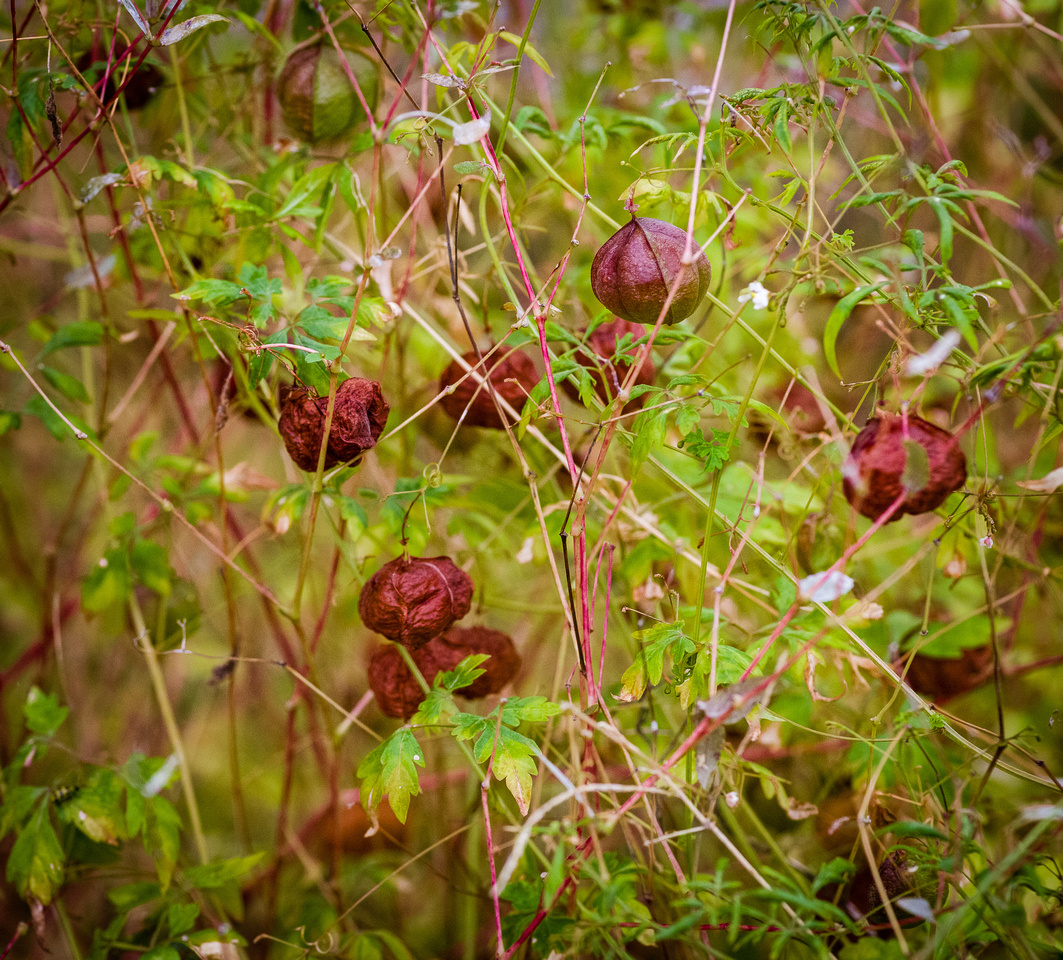
Mississippi River Botanic Series, No. 14
"We are saved in the end by the things that ignore us."
-Andrew Harvey [1]
Among the things I like to photograph are those that have no apparent human value. I like things that have nothing to do with us, that offer us no advantage and that have not been swept up in the tidal pull of commodification. I like worthless things precisely because they ignore us.
The weeds, vines, and brush along the shoreline of the Mississippi River are among such things. They are a thorny nest of useless things that grow up among the mud, rocks, and driftwood left behind by the receding river.
It takes time and patience to see the beauty of this overgrown tangle. At first, it seems that there is no order, no beauty, only out-of-control weeds, many of which have hostile thorns eager to stab the flesh of trespassers. And then there is the tangle of vines growing over concealed, loose rocks that plot our downfall on the steeply sloped river bank. But even imputing such motives to useless things is one last gesture of the self-centeredness from which we are about to be delivered.
As we slow down and cease grasping for large gestures of beauty, the small ones emerge. Here and there in the relentless chaos, is a little bit of order — a small cluster of seed pods caught poetically in the vines, performing in rhyme. But we will miss it if we are anxious "to see something." Only when we give up the search will it find us.
The beauty of useless things is often this way. It is given from beyond ourselves. To experience such beauty is to sense some plasticity of self. The rigid borders of the self, guarded by anxiety, cognitive control, and egoism, become fluid and permeable in the presence of such little surprises. When this happens, we glimpse a fleeting but deep truth, the fact that in the end our lives are not our own, and they are framed by purposes and mysteries much larger than us. The beauty of useless things dethrones us, reminds us that we are not the measure of all things. We are among the measured. And it is freeing.
Here in the economy of useless things lies a new self.
---------------------------------
[1] Andrew Harvey, A Journey in Ladakh (New York: Houghton Mifflin, 1983), 93. Quoted in Belden Lane, The Solace of Fierce Landscapes: Desert and Mountain Spirituality (Oxford: Oxford University Press, 1998), 57.
]]>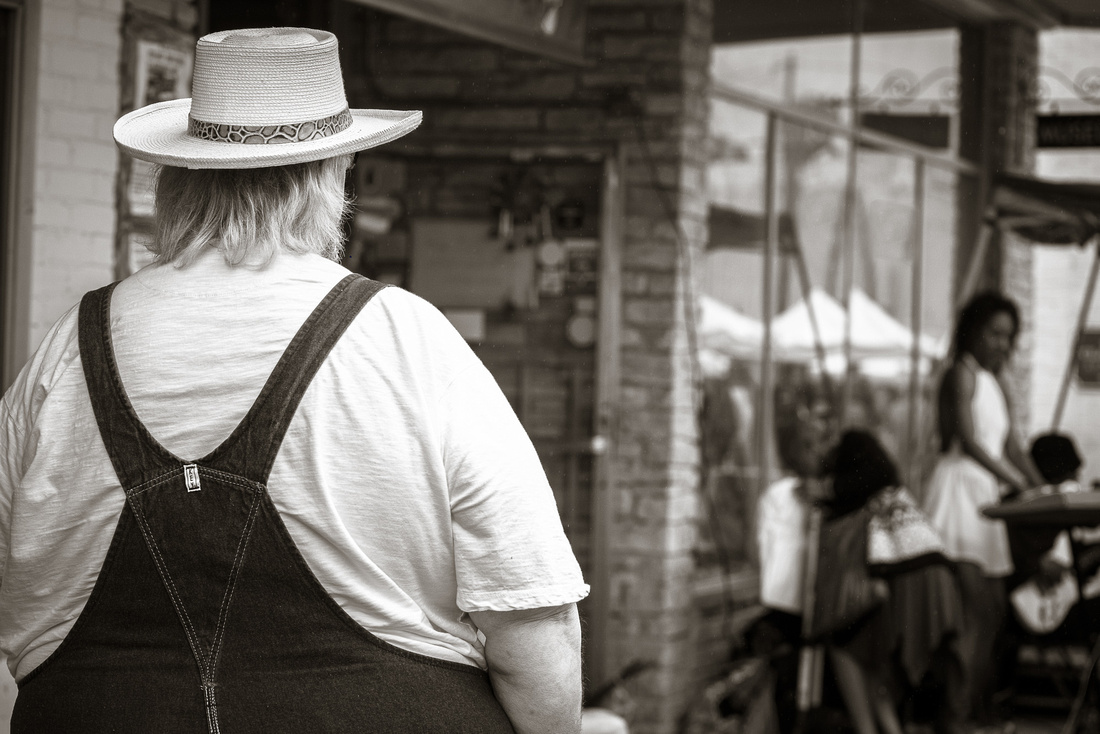
After the Miracles are Gone, 2017
"Do we know what it means to be struck by grace? It does not mean that we suddenly believe that God exists, or that Jesus is the Saviour, or that the Bible contains the truth…. Furthermore, graces does not mean simply that we are making progress in our moral self-control, in our fight against special faults…. [Grace] strikes us when, year after year, the longed-for perfection of life does not appear, when the old compulsions reign within us as they have for decades, when despair destroys all joy and courage. Sometimes at that moment a wave of light breaks into our darkness, and it is as though a voice were saying: ‘You are accepted. You are accepted, accepted by that which is greater than you, and the name of which you do not know. Do not ask for the name now; perhaps you will find it later. Do not try to do anything now; perhaps later you will do much. Do not seek for anything; do not perform anything; do not intend anything. Simply accept the fact that you are accepted!’ If that happens to us, we experience grace. After such an experience we may not be better than before, and we may not believe more than before. But everything is transformed...."
-Paul Tillich[1]
"The blues…is an impulse to keep the painful details and episodes of a brutal experience alive in one’s aching consciousness, to finger its jagged grain, and to transcend it, not by the consolation of philosophy but by squeezing from it a near-tragic, near-comic lyricism.”
-Ralph Ellison[2]
In the Gospels, we find many stories in which Jesus healed people. A woman follows quietly behind him and touches the hem of his garment and is healed instantly. Four good, strong friends lower a man through the roof of a building to interrupt Jesus so he will heal their friend, and Jesus does it. In Jericho, a blind panhandler named Bartimaeus, despite being sternly ordered by the authorities to be quiet, yells out to Jesus as he passes by, “Jesus, Son of David, have mercy on me!” And Jesus heals him. The healing stories are surely dramatic. Who doesn’t love a good old-fashioned miracle story?
But when I am honest, I must admit that these stories leave me with as many questions as answers. What about all those other people in the crowd just as much in need of healing as the woman but who couldn’t get close enough quickly enough to touch Jesus’ garment because he was moving too quickly or the crowds were too thick? What about all those other broken people who don’t have four good, strong friends willing to dismantle a roof to get them healed? What about all those other quiet panhandlers in Jericho in need of healing whose voices were drowned out by the one loud mouth who stole the show? For every individual fortunate enough to be healed miraculously by Jesus, there are throngs of people just as much in need of healing that he never heals, at least not miraculously and dramatically.
Where do these folks go to get healed? Some go to church, I suppose. Others go to Blues festivals, at least that’s now what I believe after photographing the Juke Joint Festival in Clarksdale, Mississippi for several years. Clarksdale and the Blues are for broken and flawed people, suffering people who, for whatever reason, can’t seem to get healed instantly, dramatically, and miraculously by Jesus in the usual places.
Whatever the seat of our particular suffering, when the Blues are performed, we run our fingers over the jagged edges of our brokenness, our inadequacies, our suffering. We feel the sharp-edged pain of our failure to get skinnier, smarter, wealthier, healthier, younger, prettier, or holier. We confront the loss of failed relationships and the host of other moral inadequacies and untamed compulsions that still reign in us. And we touch the hopelessness and despair awakened by a world hellbent on violence and injustice. The Blues give voice to this tragic reality, this tangle of finitude and brokenness that is inescapable in all human life. In this regard, the Blues are more honest than what often happens in church. The Blues are a much messier form of healing than miracles, and perhaps that’s why they persist long after the miracles are gone.
But the Blues do more than give voice to the brokenness in our lives. They enable us to transcend it, to squeeze from it some inexplicable, ineffable triumph. Let's call it grace. No, let's be bold. Let's call it Gospel, "good news" that blesses Luke's "poor" and Matthew's "poor in spirit." By singing about suffering, the Blues ultimately beat it, well, kind of. They beat it, albeit in an oblique way, with humor, pathos, and permission to embrace our bodies and spirits as they are. They beat it by unshackling bodily and spiritual desires, emotional longing, and the satisfaction of all of these from the shame and violence of false moralism and the politics of domination.
The Blues knit wounded selves back together again. They do so not by extricating us from the cruelties of life. That would be too easy; that would be cheap grace and bad music. The Blues are cruciform grace; they make power present through weakness. In them, we find divine grace incarnate in human suffering well after the miracles are gone.
It is foolish, of course, to say that everything sung in the Blues is Gospel; surely the Blues too are fragile and susceptible to the very tragic misdirections and distortions that they themselves identify. To say this is simply to recognize that old truth that not every word the preacher utters is Gospel; and yet sometimes the preacher's clumsy or even self-serving words become Gospel through the power of Another. So it is with the Blues.
[1] Paul Tillich, “You Are Accepted,” The Shaking of the Foundations (New York: Charles Scribner’s Sons, 1948); pp. 161-2.
[2] Ralph Ellison, "Richard Wright's Blues," in Shadow and Act (New York: Quality Paperback Book Club, 1994 (1964)); p. 78. Quoted in James Cone, The Cross and the Lynching Tree (New York: Orbis Books, 2013); p. 16.
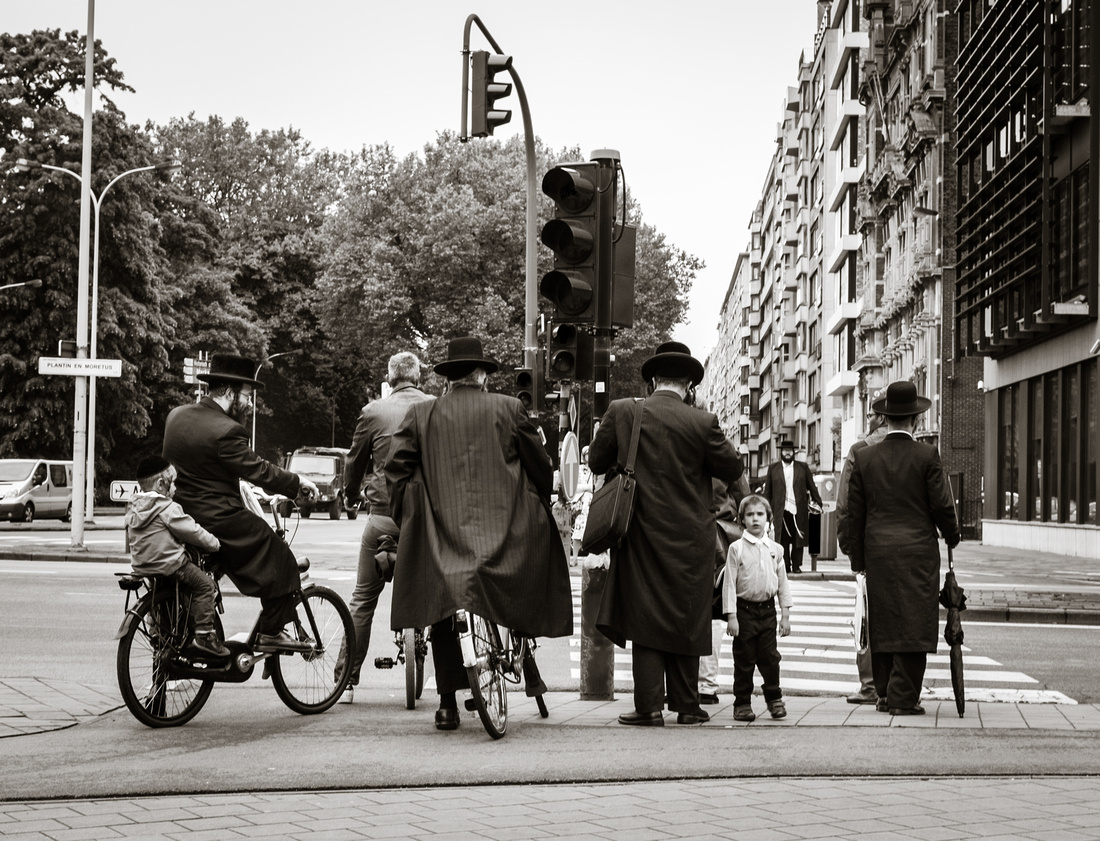
The Jewish Boy, 2017
"The face opens the primordial discourse whose first word is obligation."
*****
"The Other faces me and puts me in question and obliges me."
*****
"The face resists possession, resists my powers.... The face speaks
to me and thereby invites me to a relation..."
*****
"The face is what forbids us to kill."
-Emmanuel Levinas [1]
In the fourth chapter of Night, Holocaust survivor Elie Wiesel recounts a scene from his time in a Nazi concentration camp that few readers can ever forget. Wiesel describes the public hanging of a young Jewish boy accused by the Nazis of sabotage. Public hangings by the Nazis were not uncommon in the camps as part of the comprehensive strategy of terror. But never had the Nazi guards publicly hung a young boy. When describing the boy, Wiesel notes that he "had a delicate and beautiful face -- an incredible sight in this camp." As the boy dropped from the gallows, it became clear that his little body did not have sufficient weight to snap his neck, ensuring a quick death. Instead, his body twisted and writhed as he slowly suffocated to death. As his delicate body dangled in sky, Wiesel notes that a change came over the otherwise hardened prisoners. For the first time, they came face to face with the profound sense of the absence of God. What kind of a God allows delicate-faced little boys to be tortured to death as public spectacle? For Wiesel there was no easy theological answer, just an overwhelming sense of divine abandonment in the presence of irredeemable evil. Like the prophet Jeremiah, all Wiesel could do was shake his fist at God, crying out in anger and protest, demanding that God be God. [2]
As I was walking in the Jewish neighborhood of Antwerp, Belgium recently I decided to sit and rest near a busy intersection. It was morning, and the Hasidic parents were escorting their children to school on their way to work. As Jewish men gathered to cross the street, a little Jewish boy with "a delicate and beautiful face" turned around to watch me as I began to photograph him. His gaze met mine.
I do not know the boy's name. I do not know his age. I know nothing about him, save one thing. I know his face, framed as it is by his strange shylocks. His posture and position next to the grown men, themselves strangely attired, accentuate the smallness, fragility, and awkwardness already carried in his gaze. His might just as easily have been the face of that other Jewish boy twisting on the end of a Nazi rope.
In the end, it was the gaze of his "delicate and beautiful face" that stopped me in my tracks. This was no mere photo op. Here was a disruption, a call to something deeper than a snapshot stolen on the run. Here was a brief but powerful call to connection, empathy, and even moral and spiritual transformation.
Jewish philosopher Emmanuel Levinas helps us make sense out of our encounters with the gazing faces of such strange and foreign others by seeing in them both a disruption and a summons.
Here was a disruption of my common ways of seeing the world that assume that it and others must conform to my expectations and norms if they are to be worthy of my moral regard. Here in the face of this particular Other was resistance to my desire for sameness that anonymizes and invisibilizes individuals, thus blunting my sense of empathy with and moral obligation toward them. Here too was a summons out of inauthenticate selfhood, rooted in anxiety and control. Here was a summons into an intersubjective world rich with empathy, moral obligation, and affective regard for the wellbeing of a strange and foreign Other. In his face, I found an invitation out of the habits of my false and hegemonic self that tempt me to look away to avoid his gaze, thereby short-circuiting the emergence of empathy, connectedness, and spiritual transformation that meeting his gaze might occasion.
It is difficult for us to grasp the depth of evil that produces genocides. We are sometimes tempted to explain such evil by appealing to supernatural origins and the idiosyncrasies of individual personalities. Only demons and devils could twist a person into a Hitler, we say; thus tacitly reassuring ourselves that he is a monster thoroughly unlike the rest of us. Other times, we chalk Hitler up to mental illness, his evil the product of an atypical psychopathic personality; again tacitly reassuring ourselves that he is an exception, an anomaly. Such explanations are false because they eclipse the social forces and broader cultural dynamics that produce such so-called "madmen."
The danger of such "explanations" is that they prevent us from engaging in more self-critical analysis. When Hitler and Holocausts are presented as suddenly storming unannounced onto the stage of history, it discourages us from asking the deeper questions of who built the stage on which they appeared. The truth is that that the grounds for such evil must be first be cultivated over time in society, a complex process that ultimately enlists all of us as accomplices eager to look away from the face and gaze of those strange and foreign others in our midst who seem to threaten us. Evil leaders are to a significant extent the byproduct of the societies that produce them.
When I view The Jewish Boy, I see the "delicate and beautiful face" of not one but two Jewish boys, the first on an Antwerp street corner, the second twisting on the end of a Nazi rope. My hope is that this photograph prompts viewers to place themselves purposefully among the outsiders, to look into their eyes, to be drawn out of themselves into communion with those who are foreign and strange. Only when we meet the gaze of such particular faces can we encounter their, and ultimately our own, fullest humanity.
As I linger still awhile longer over this photograph, I catch a glimpse of yet another Jewish boy, but one whose name I know. He wandered in the temple, lost, vulnerable, and probably afraid while his parents searched frantically for him as they backtracked toward Jerusalem. His parents found him, of course, but only after the teachers met his gaze, greeted him, and discovered in his face the possibility of the healing of the nations. [3]
-------------------
1. Emmanuel Levinas, Totality and Infinity: An Essay on Exteriority (Trans. Alphonso Lingis. Duquesne Press, 1969), 201, 207, 197, 198; Ethics and Infinity (Trans Richard A Cohen, Dusquesne Press, 1964), 86. I am indebted to Bruce Young who identified these and other quotations that synopsize key elements of Levinas's philosophy. See http://english.byu.edu/faculty/youngb/levinas/face.pdf.
2. Elie Wiesel, Night. (Trans. Marion Wiesel. Hill and Wang, 2006)
3. For the account of Jesus in the Temple, see Luke 2:42-52.
]]>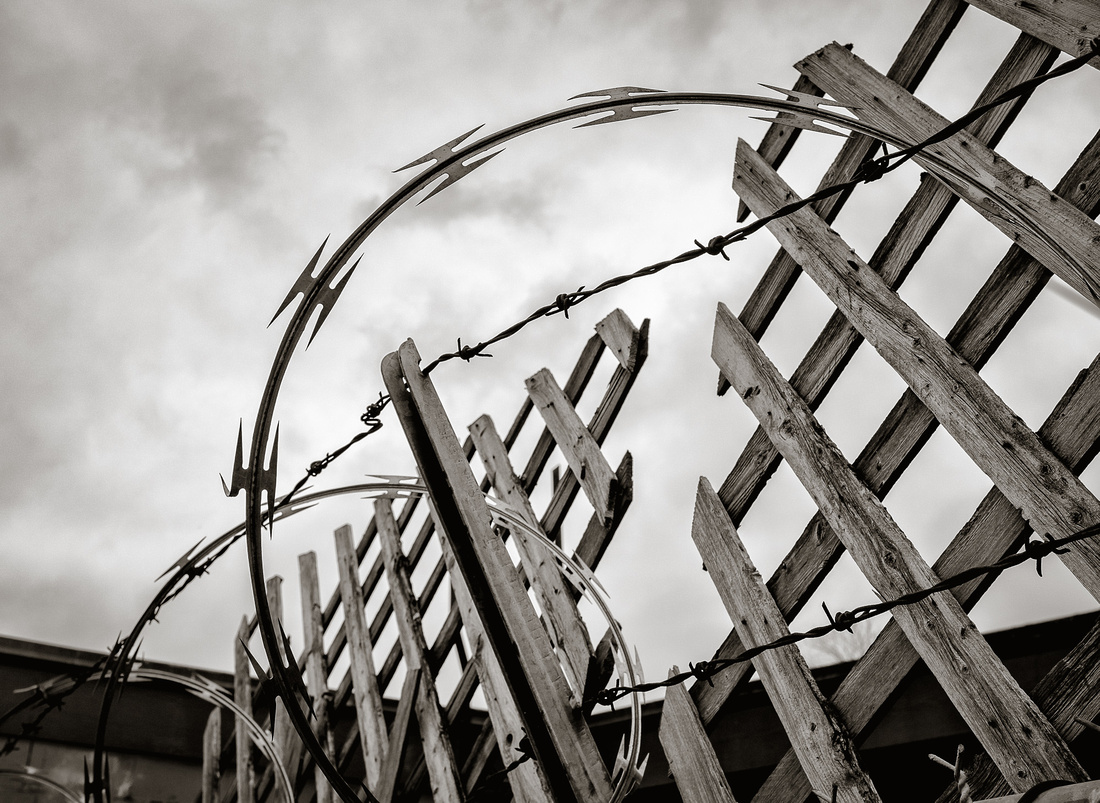
Razor Wire and Broken Fence behind the Happy Mexican Restaurant, 2017
Two fish were swimming side by side in the ocean. The first said to the second, "the water is warm and clear today." The second responded, "what water?" [1]
Attentiveness does not just happen. It must be cultivated. We can only be awakened to deeper seeing, and ultimately to deeper living, if we teach ourselves to pay attention.
The men and women who began moving to the deserts of Egypt and Syria in the third and fourth centuries to practice a contemplative desert spirituality knew this. Theirs was a world in which faithful living had become difficult. It was made difficult by the emergence of an empire which often cloaked its quest for military conquest, economic domination, and exploitation of the vulnerable in Christian symbols and rhetoric. Beginning with Constantine in the early fourth century and extending down through the history of "Christendom" to our own time, the Prince of Peace has often been gradually transformed into a triumphalist, flag-waving Jesus who sanctifies the imperial bid for domination, exploitation, and the suppression of difference in the name of security and patriotism. In a fateful dream on the night before his greatest battle at the Milvian Bridge, Constantine saw the Chi-Rho and heard the words, "in this sign, conquer." His dream seems to be a common one.
The driving question for these desert contemplatives was simple but profound, how do we live faithfully in a world where the faith we profess has been co-opted by empire? It was a subversive, unpatriotic, unwelcome question, and it remains so in this, our own season of empire.
The desert contemplatives answered this question by withdrawing from the world to live in the desert. While they withdrew from empire, they did not abandon the struggle against it. They knew that the line between our inner and outer landscapes is porous. They withdrew from the outward world of empire so that they could focus on the ways that empire comes to occupy the inner world of the soul. These desert monks knew that the political, military, and economic engine of empire was fueled by that other, more pernicious and elusive form of empire that colonizes the heart, enslaves the imagination, and infects all the small and ordinary activities of daily life in ways that often remain invisible to us.
At the heart of their strategy of resistance, lay spiritual practices such as prayer, meditation, worship, fasting, extending hospitality to vulnerable guests, engaging in mutual correction, gardening, basket weaving, and caring for the sick, exploited, and outcasts of empire. They knew that we cannot merely profess a counter-cultural spirituality; we must train for it daily by reimagining even the most mundane of daily practices, freeing them from the dynamics of violence, domination, and exclusion pursued in Jesus' name. Such practices exorcized the demons of empire that dwelt in the heart and that keep empire alive in the outer world of politics, economics, and culture. The conflict with empire was indeed a cosmic conflict with "the powers and principalities of this present age," but victory would come only by prevailing in the small skirmishes of ordinary daily life. Victory would come by changing one's diet, clothing, sleeping practices, labor, and social circles. [2]
The spiritual disciplines aimed at many things, but among the most important of them was the cultivation of prosoche, attentiveness. Attentiveness is mindful seeing, purposefully lingering before things so that they may reveal themselves on their own terms and in their fullest depth and complexity. Pursuing prosoche meant learning to see the world as it really is rather than through the distorting lens of anxiety and acquisitiveness brought to it by the false, fallen self. Practicing prosoche meant observing carefully, deliberately, and dispassionately the subtleties of things as they really are. Such attentiveness awakened a heightened sense of nuance, a new-found comfort with complexity and ambiguity, and joyful delight in the variegated beauty of ordinary, mundane things. To practice prosoche was to retrain our eyes to see the world as God would have us see it, undistorted by the possessiveness and drive for domination rooted in the false self of empire. Pursuing prosoche was an antidote to illusion, a celebration of the realness of things as they are in their naked givenness and stark facticity. To engage in prosoche was to shatter the delusion of "alternative facts" and the spin of internalized imperial narratives of fear, threat, and conquest. Cultivating prosoche meant deepening one's capacity for complexity, making room for the foreignness of things and other people. [3]
Prosoche was closely related to diakrisis, that form of wise, patient discernment that makes nuanced, measured judgments informed by carefully seen, subtle, relevant distinctions. [4] Together Prosoche and diakrisis undermined the reductionistic, binary oppositional thinking demanded by imperial propaganda and the politics of fear and exclusion. Prosoche and diakrisis were an inoculation against the self-serving oversimplifications produced and required by our anxious, imperious drive for domination and control. To recast things in more contemporary terms, attentiveness and discernment destabilize "either-or," "yes-no," "us-them," "black-white," "insider- outsider," "liberal-conservative," and "deserving-undeserving," for example. By so doing, they school the imagination in resistance to the reductionistic thinking demanded by empire.
Simplistic binary oppositional thinking and living have again become a mark of our age. They are fed by political memes on social media, pithy bumper stickers, "news" networks that pluck only partisan soundbytes from complex stories, political propaganda, and extremist blogs masquerading as reliable sources of news. They are also fed by the fundamentalist religion of the right, and, if we are honest, of the left as well. Such thinking thrives on fear and anxiety, promising us a seemingly irresistible form of clarity and certitude about the dangerous world before us. Such thinking seems to bring a reassuring order to the swirling chaos of our troubled world.
But if the ancient desert contemplatives can teach us anything, it is that such simplistic thinking is driven by that old, false self within us, that self that would be its own god. And perhaps we can learn from them to cultivate prosoche and diakrisis again. We cannot, of course, simply mimic their ancient spiritual disciplines in some desperate flight of nostalgia. We will need to adapt them in ways suitable for our own time. Part of such adaptation will mean that we consider again the power of art and artistic creativity in our daily lives.
I have walked behind the Happy Mexican Restaurant in a struggling section of downtown Memphis many times. Its façade is painted in bright colors and bears kitschy images of stereotyped mariachi singers whose dark, gap-toothed faces grin without pause. But behind the Happy Mexican, smiling faces give way to a tall fence, a tangled weave of metal, broken wood, and razor wire designed to keep thieves and vandals out. Behind the fence are dumpsters filled with the rotting food scraped from last night's plates. Next to these is a large grease trap that holds the discarded, acrid oils from the kitchen fryer. It stinks behind the Happy Mexican, and it is surely an ugly place.
And yet, as I stood next to the fence for a twenty minutes studying the shapes and patterns, I was struck by the graceful curves of the razor wire designed to tear flesh. The pattern of the fractured wood lattice behind it only multiplied the strange beauty of geometry set against the sunless grey sky. Here in ugliness was beauty. But this beauty did not erase ugliness. The fence was ugly and beautiful at the same time, a soiled, secular sacrament suspended in the sky. My eye said both "yes" and "no," and the longer I looked the more richly commingled they became. Here was a moment of prosoche, that deep attentiveness to the complexity of the world that awakens diakrisis, discerning judgment at home with ambiguity, complexity, and even paradox. The givenness of this little, smelly scene disrupted the simplistic impulse to add it quickly to the column of ugly things and rush on in search of something pretty to balance the imperial ledger.
I do not think a single encounter such as the one behind the Happy Mexican will expunge empire from the mind. But perhaps as the desert contemplatives thought, cultivating such encounters in the small, daily skirmishes of ordinary life will eventually help us do so. At any rate, that evening as I watched the news, lying presidents, spying microwave ovens, make-believe wiretaps, chest-thumping patriotism, inept propaganda, and the political memes of social media seemed just a bit farther away.
Maybe a fish was becoming aware of the water.
-------------------------------------------------------------
- Borrowed and paraphrased from David Foster Wallace, "This is Water." Commencement Address at Kenyon College, May 21, 2005. Transcript available at https://web.ics.purdue.edu/~drkelly/DFWKenyonAddress2005.pdf
- For a general introduction to the rise of ascetic, contemplative desert spirituality in late antiquity, see Derwas James Chitty's, The Desert a City: An Introduction to the Study of Egyptian and Palestian Monasticism Under the Christian Empire (St. Vladimirs Press, 1977). For a more focused treatment of the emergence and role that the desert contemplatives played in the context of empire and its complex patronage system, see Peter Brown's classic essay, "The Rise and Function of the Holy Man in Late Antiquity" (The Journal of Roman Studies, Vol. 61 (1971), pp. 80-101). Brown's essay is available online at https://faculty.washington.edu/brownj9/LifeoftheProphet/The%20Rise%20of%20the%20Holy%20Man%20-%20Brown.pdf
- Douglas E. Christie, The Blue Sapphire of the Mind: Notes for a Contemplative Ecology. Oxford: Oxford University Press, 2013. See especially chapter 5, "Prosoche: The Art of Attention," pp. 141-78.
- Christie, 148
]]>
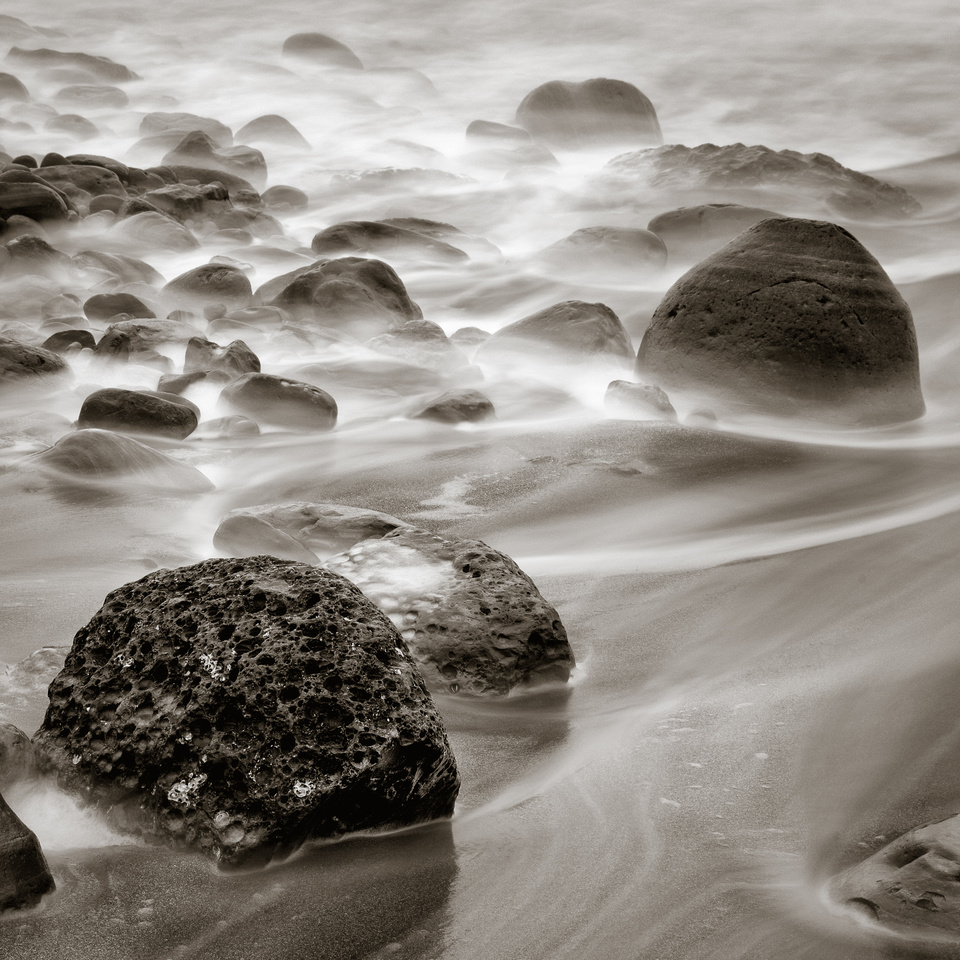
Boulders in the Surf, No. 2
Every summer when I was a boy, my parents would take us on vacation to Santa Cruz, California. For a household of boys, there was no place better on earth than Santa Cruz. We divided our time between three great attractions, the pier from which we fished, the beach where we swam and built sand castles, and the boardwalk where we indulged the world of carnival and theme park. The boardwalk was for evenings, and we filled them with rides on the Big Dipper, the Mighty Mouse, and the Log Jam. When we weren't riding the rides, we played games, and most importantly for me, created "spin art."
Nourished on the ambrosia of cotton candy and caramel apples, we made our way to the south end of the boardwalk, to the spin art booth. And here, like the Creator hovering over the primordial darkness and void, we hovered over a chaotic, paint-stained counter eager to create. At each station was a machine to which the operator attached a piece of blank rectangular art paper than spun around so fast it became a blurred circle. Here was our canvas, and there was no need for paintbrushes. Instead, for ten frenzied minutes we squirted streams of paint from plastic bottles onto the spinning paper. We learned to squeeze softer and harder. We learned how to press an awl gently against the spinning paper to inscribe texture and blend the paints.
And when we finished, and only when we finished, the operator would stop the motor that spun the paper. And then for the first time, we would behold the finished artwork sitting still before us. It was our moment of revelation. Then the orange-aproned operator, like a priest reverently raising the Host, would delicately lift your masterpiece from the machine and set it aside to dry before you returned to collect it. Nourished and tired, we proud Picasos toted our artwork back to the Salt Air Court where we transformed our little white motel room into a gallery.
I got hooked on spin art. Perhaps it was largely because I was not yet old enough or tall enough for many of the gut-jumbling rides enjoyed by my older brothers. But there was another reason, the thrill of waiting and not knowing, the thrill of the big surprise at the end. For those ten minutes of squeezing paint on spinning paper, my creative intentions and gestures were taken up by wild centrifugal forces beyond my control to produce something that was at once mine and not mine. All my technique and craft, in the end, were gathered up by the machine and spun wildly into something over which I ultimately had no control. Spin art happened in the unpredictable space between artistic intention and technique, on the one hand, and chance and cosmic forces, on the other. Here was theme park eschatology -- a boy living by artistic faith, confident that beauty would emerge from the tension-filled space between paint applied and paint drying.
It has been over thirty five years since I have made a piece of spin art on the breezy boardwalk by the sea. But just a few weeks ago, I stumbled into it again. Well, sort of. This time it involved no paper, paint, or spinning machine. With camera in tow, I descended the dunes to an isolated stretch of untamed beach along the Pacific coast in California. The beach was scattered with boulders large and small. As the waves of high tide crashed mightily, they tossed the boulders into one another, creating an eerie thunder on a foggy morning.
I chose to make long photographic exposures, slowly recording the water as it rolled unpredictably over and around the boulders. Once opened, the shutter remained open for many seconds, and what happened during that time was beyond my control. I could anticipate when waves might crash and where water might flow and trip the shutter accordingly, but in the end what happened in those seconds was always unpredictable, surprising, and beyond my control. Sometimes the water foamed unexpectedly as it took its uncharted path around the rocks before beginning its streaky return to the sea. Sometimes incoming waves collided with returning waves and produced watery volcanoes of churning sand. For those seconds when the shutter was open, the water went where it wanted, when it wanted, in the ways in wanted, and how the camera would record this was equally a mystery. All I could do was trip the shutter, wait, hope, anticipate.
Here was spin art of a higher order.
Here was a middle-aged man reborn a boy by the briny baptism of the sea.
Here again was the eschatology of creativity, suspending my awareness between present intention and future outcome, between purposeful technique and cosmic surprise.
Here again was the undiluted wonder, potent mystery, and unfettered delight that too often only mystics and children know. And maybe messiahs.
"Let the little children come to me," he said. [1]
-------------------------------------
1. Matthew 19.14. New Revised Standard translation.
]]>
Boulders in the Surf, 2017
I cannot photograph sound.
And yet, twice in the past year I have desired to do so. In January of last year, following a snow storm in the Sierra Nevadas, I journeyed up to Yosemite to photograph. I began my circuit of the Valley with a stop at Bridal Veil Falls. The footpath to the base of the falls was covered in several inches of treacherous ice. Most of the few visitors in the park who bothered to stop chose to forego the walk and view the falls from the safety of the parking lot. As I gingerly worked my way up to the base of the falls, I heard peals of thunder overhead. But the skies were blue. It was not thunder. It was the sound of large sheets of ice high above the falls cracking, breaking loose, and smashing against rocks on their way over the cataract. This strange, thunderous sound echoed sharply over the whole of Yosemite Valley.
And just a few mornings ago, I stood atop a rocky shelf along an isolated stretch of untamed Pacific coastline at Montaña de Oro State Park. It was a foggy morning, and again I heard the sound of thunder that was not thunder. It was the sound of large, submerged boulders on the shoreline being lifted and tossed violently against one another by the fierce waves of high tide.
There is something unsettling and eerily fascinating about this thunder of ice, rocks, and water. Immanuel Kant and the Romantic thinkers and artists of the nineteenth century would likely have categorized these encounters as experiences of the sublime. The sublime, they insisted, is different from the beautiful. The beautiful refers to things on a human scale -- small, delicate, pretty, and manageable by the mind. Experiences of beauty evoke an immediate sense of satisfaction and unalloyed pleasure as one perceived the presence of symmetry, form, and balance. Beauty awakens a sense of being at-home in the world. Beauty consoles, comforts, and reassures. The mind is up to the task of beauty.
Experiences of the sublime are different, insisted Kant and the Romantics. We experience the sublime when we are confronted and overwhelmed by the vast, unbounded, primal forces of the universe. When we experience the sublime, we are radically disoriented. We feel swallowed up by the vastness of cosmic forces and sense acutely our smallness and vulnerability in the grand scheme of things. For Kant, it was the vastness of "the starry sky above" that evoked a sense of the sublime. The power of ocean tides and echoing peals of thunder have the same effect. These experiences of boundlessness, displace and dislocate us, disrupting our cognitive powers. When they do, they evoke something other than a simple, direct sense of pleasure and at-homeness in the world. Instead, they pull us affectively in multiple, contrary directions all at once. [1]
Rudolf Otto, while writing about "the holy," might just as easily have been writing about the sublime. Otto characterized a holy object as a mysterium tremendum et fascinans. [2] Holy things are mysterious, "wholly other" things that confound the mind and evoke a sense of fear and fascination at the same time. We are drawn irresistibly across treacherous terrain to the cracking ice and jumbling boulders even as we pull back with caution and fear at their danger and disregard for us. The thunder of rocks, water, and ice calls out to us to come closer for a better look even as we know that with one misstep these elemental forces can kill us. To feel these countervailing impulses at once is a mark of the sublime.
This distinction between the beautiful and the sublime is not without its problems. Repeating the gender essentialism of patriarchy, for example, nineteenth-century thinkers identified beauty with the feminine and the sublime with the masculine. And while it was not their intention to diminish the significance of the beautiful in the interest of the sublime, such was often the effect in practice when the distinction became gendered. Patriarchy demands beautiful but subordinate women rather than sublime ones. The former please and serve men, while the latter threaten to undo them. [3]
And yet, despite the problematic overlay of patriarchy and gender essentialism, one senses an authentic insight here into some kinds of aesthetically charged experiences. Tangled and muddled by gender politics as this distinction is, we do, in fact, have these experiences of the sublime, and they are different from other experiences of beautiful things.
Such experiences of the sublime are powerfully formative. They shake us awake from the slumber of our grasping egocentrism. We discover that we are not the center, force, and fulcrum of the universe. We sense our smallness and vulnerability again, and paradoxically it is liberating. They free us from the compulsive drive to control reality, from the fear that drives us into the arms of false messiahs who promise to make us great again.
I cannot photograph the thunder of water, rock, and ice, and that fact is a palpable reminder that I am not the measure or even measurer of all things. But perhaps a photograph such as Boulders in the Surf can crudely and clumsily bear witness, even if only obliquely, to the sublime, to the fact that "we are saved in the end by the things that ignore us." [4]
-----------------------------------------
1. For a brief overview of the distinction between the beautiful and sublime in Kant and Romanticism, see Elaine Scarry, On Beauty and Being Just (Princeton: Princeton University Press), 82-6.
2. Rudolf Otto, The Idea of the Holy. Trans. John W. Harvey. Oxford: Oxford University Press, 1923; 2nd ed., 1950 [Das Heilige, 1917].
3. For a more comprehensive critique of the distinction between beauty and the sublime, see Scarry, On Beauty, 82-6.
4. Anthony de Mello, One Minute Wisdom. Quoted in Belden Lane, The Solace of Fierce Landscapes: Desert and Mountain Spirituality (Oxford: Oxford University Press, 1998), 57.
]]>

Train Cars, Rudyard, Mississippi, 2016
Ours is an age that has come to think of beauty and art as luxuries easily done without rather than as necessities required for living well.
Our willingness to dispense with them is written into much modern home construction and neighborhood development, for example, where our fetish for more and cheaper square footage and uniform design eclipses attention to the flow and arrangement of space, the presence or absence of natural light, and the unique, artful character imparted to a living space by careful attention to detail and variety. This impulse to dispense with beauty and art is also present in our educational institutions, where art programs are the first ones cut when budgets must be trimmed. The kids can do without paint, clay, and crayons, but they can't do without math and science, standardized tests, and computer skills, or so says the unimaginative "wisdom" of our age.
And on the few occasions when we finally turn in the direction of beauty, we easily get distracted by the pretty, by ornaments and decorations that lack depth or complexity. We want art that matches the couch rather than touches the soul. We confuse beauty with decor.
What exactly is lost when we slowly drift away from beauty and art?
Answering this question requires that we ask a more basic one, what makes a thing beautiful? Across the western intellectual tradition, the answers to this question has been complex and varied. But there is one aspect of the answers that recurs in nearly every age; and that is form. Form refers to the organizing principle of a thing, the integrative aspect that binds its parts into a harmonious whole. Form imparts orderly arrangement, coherence, and structure to an entity. A natural or artistic entity is beautiful when its various aspects are organized, integrated, and patterned harmoniously. Form expresses itself as the arrangement and order within a thing that make it a unified whole, something greater than the mere sum of its parts. Form sometimes goes by its Christian name, Logos, or by its Jewish name, Wisdom.
Form is what differentiates music from noise. If I drop my kitchen pots and pans on the floor, they will strike many of the same notes as the organist playing Beethoven's "Ode to Joy." But why is this noise rather than music? It is noise because the notes are not well ordered and harmoniously arranged. They lack proportion and symmetry, structure and coherence, integration and unity. The difference between "Ode to Joy" and clanging cookware is that the former has superior form while the latter lacks it almost entirely.
When we experience the form revealed in beauty, we feel down deep in our gut that the world in which we live is governed by order rather than chance, purpose rather than accident, pattern rather than chaos. In the presence of beauty, we sense deeply that our lives and the existence of all other things fit together in some coherent way that is ultimately meaningful. The experience of beauty awakens and intensifies that felt sense that the universal power that generates and integrates our lives is greater than the powers that seek to pull them apart. We are assured affectively that the universe is shot through with meaning, that its primal force is an integrative love, and that life is well lived when it consents to the harmony that binds all things together and yokes them to their transcendent purpose. Our native response to perceiving form in beautiful things centers in delight and joy that reorder the heart's deepest desires, drawing us out of ourselves toward the other in exuberant, spontaneous love.
To experience the form present in beauty is to hear a transcendent Witness declare that the world is good; that it is as it ought to be, and that there is room for us in it. The form of beauty awakens in us a sense of wellbeing, an intuitive, sure sense that the universe is not fundamentally hostile to our existence despite the reality of suffering in our lives. Beauty reveals the joyful truth that my life is never wholly my own own, that power and pose cannot ultimately trump goodness and truth. Form revealed in beauty exposes the lie that the only meaning my life has is whatever arbitrary meaning I or society assign it. The form manifested in beauty awakens hope, a sense of possibility, and a sense that life, love, and justice ultimately matter. Beauty thus gives birth to our moral imagination and awakens moral motivation.
In the end, the real danger of a beautyless, artless world is not so much ugliness but nihilism, the loss of that existential meaning that is bedrock to our humanity.
]]>
California Sea Otters, Mother and Pup, 2016
When I was a boy, I raised pigeons. I enjoyed releasing them many miles from home and finding that they had returned to the coop. On very rare occasions when two steel-grey homing pigeons mated, the plumage of their offspring was not at all like that of the parents. The parents had "thrown a pie" as pigeon-keepers called it. The plumage of the offspring was mottled, dappled in odd colors, and uniquely its own -- the wild resurgence of recessive genes. -MTM
|
Pied Beauty Glory be to God for dappled things-- For skies of couple-color as a brindled cow; For rose-moles all in stipple upon trout that swim; Fresh-firecoal chestnut-falls; finches' wings; Landscape plotted and pieced--fold, fallow, and plough; And all trades, their gear and tackle and trim.
All things counter, original, spare, strange; Whatever is fickle, freckled (who knows how?) With swift, slow; sweet, sour; adazzle, dim; He fathers-forth whose beauty is past change: Praise him.*
-Gerard Manley Hopkins, 1877 |
------------------------------
*This poem is in the public domain.
]]>
Toadstool and Pine Needles, 2013
In My First Summer in the Sierra (1911), John Muir offers the following account of sketching a sugar pine tree in the Sierra Nevada.
| I never weary of gazing at its grand tasseled cones, it's perfectly round bole one hundred feet or more without a limb, the fine a purplish color of its bark, and its magnificent outsweeping, down-curving feathery arms forming a crown always bold and striking an exhilarating... At the age of fifty to one hundred years it begins to acquire individuality, so that no two are alike in their prime or old age. Every tree calls for special admiration. I have been making many sketches, and regret that I cannot draw every needle. [1] |
In the midst of a creative act, Muir discovered that "no two [trees] are alike." So intense is his insight that he longs to sketch each and every pine needle because one cannot substitute for another without loss. Muir was smitten by the power of particularity.
Artmaking opens up this power of particularity in our lives, evoking a deeply felt sense of the irreducible uniqueness of the single thing in front of us right now. Under its spell, we linger over the minutest detail, offering it a long, loving, sensuous gaze. As we do, everything else fades temporarily from view. It is as though time stops and we are wholly absorbed in the intricacy of this and only this thing. We come to know it immediately, intimately, and vividly. We lose ourselves in it only to find ourselves again, but now we are richer for having been woven together intimately with the object and the felt mystery it makes present.
As we sketch, photograph, or paint the pine needle, we are so keenly focused on its particularity that the boundaries between subject and object dissolve. The anxiously patrolled borders of the self become porous, fluid, and elastic. The self relinquishes its drive to control -- physically, emotionally, and cognitively. The ego discovers itself open, receptive, and vulnerable. Curiosity dissolves control, empathy replaces hostility, love banishes indifference. Before the pine needle and the felt sense of mystery that envelops it, delight, wonder, and hospitality crowd out fear, hatred, or violence. The self makes room for the pine needle and allows it to be what it is, fragile, beautiful, vulnerable. And now loved.
This kind of artistic awareness is very much like the mystical awareness treasured by the contemplative traditions in nearly all of the great religions of the world. These are not experiences of flight from the world, from the ordinary, from the particular. Rather, they are experiences of a radically new way of being present to the world, to the ordinary, to the particular. When we linger over the beautiful thing, suddenly we and it are cradled in the arms of the Whole, the mysterious Whither and Whence of all being. We have celebrated Communion.
There is a deep paradox here, and it is this. When we severely restrict the scope of our attention to a single being, giving it our total attention and devotion, it becomes a portal onto the Whole. In seeing the one, we awaken to the All. Only by restricting our awareness does it become expansive and capacious. If it is Logos we find, it is always first incarnated.
This graced form of awareness is not the exclusive possession of professional artists or the mystical virtuosi. It is available to all of us, but we must cultivate it. Among the ways we do so is by exercising creativity, by making art. Many of us gave up artmaking when we grew up, shamed out of it by the demands of adulthood and "serious" living. But creativity and art-making are deeply spiritual, transformative practices, capable of renovating our imaginations and reorienting our total affective and cognitive posture toward life over time. When we neglect them in our adult lives, we do so at our own peril.
But what do pine needles have to do with politics? At this moment in American political life, we are a deeply divided people. Beneath our political, cultural turmoil is a deeper spiritual turmoil. We are a people governed by fear, alienation, and isolation. Our fractious politics and lack of empathetic connection to one another are a symptom of our traumatized souls. We are closed off from one another and from ourselves -- angry, alienated, and desperately in search of political messiahs from any end of the political spectrum who we hope will magically rescue us from our problems. But down deep we know that no politician, party, platform, or election will do for our souls what needs doing.
What is required is work rather than magic, and it is work that we the people rather than a single political messiah must do. It's local, particular, grassroots work. It's slow, hard, and risky work. And, as silly and naive as it may sound, I believe that some of this work must be the joyful work of making art. We need to discover or rediscover the bliss of creativity. We need to sketch, photograph, and paint that pine needle right there, right now. We need to do this creative work so that we might discover the transformative power of particularity. Attending deeply to this pine needle, the one right there in front of us now, is one way of practicing ourselves into openness and receptivity to the distinctive colors, qualities, textures, and scents of every unique, irreplaceable being.
Creative work will enable us to sit first with a pine needle and later with a particular person. Schooled in empathy, connectedness, and communion by the pine needle, we will become porous and fluid, able to receive a particular person who is different and strange. Schooled by the pine needle, we will learn the name and face, the particular story, the unique gifts, the peculiar fears, and the concrete hopes of a particular other. Creative work thus generates the fundaments of love and community.
Sketching a pine needle may make it easier to sketch the particular life of a single African-American person and for the first time learn what a particular black life looks like. Only then will we know what's at stake when we say "black lives matter." Others of us will need to sit and sketch the life of a working-class, rural white man and learn about the seeds of his anger, fear, and alienation. Others of us will need to sit and sketch the life of a Muslim, a person suffering homelessness, a police officer, a single mom, or an LGBTQ person. All of us will need to sit and sketch our own particular lives, for these have become as foreign and dangerous to us as the lives of others.
This creative work will teach us the dangers of abstraction and facile generalizations that repress the moral sentiments and sever the affective bonds that knit our particular lives together into genuine community. Only when we have fully entered into the texture of another's particular life, will we learn what is lost by "all black people are...", "all white folk are...", "all blue-collar men do...", "every rich person is...", "all police officers do...". Such objectifying abstractions and weaponized generalizations are often defense mechanisms of our anxious, wounded, and fearful egos. Creativity and pine needles can help deliver us from them. And while we may eventually be able to make some helpful generalizations based on shared insight, we will make them more carefully, hold them more loosely, always testing them against the pine needles.
So, go, sketch a pine needle, that one, right there, right now; the one caught on the far side of a dangerous divide.
-----------------------------------
[1] Quoted in Douglas E. Christie, The Blue Sapphire of the Mind: Notes for a Contemplative Ecology (Oxford: Oxford University Press, 2013), p. 29.
]]>
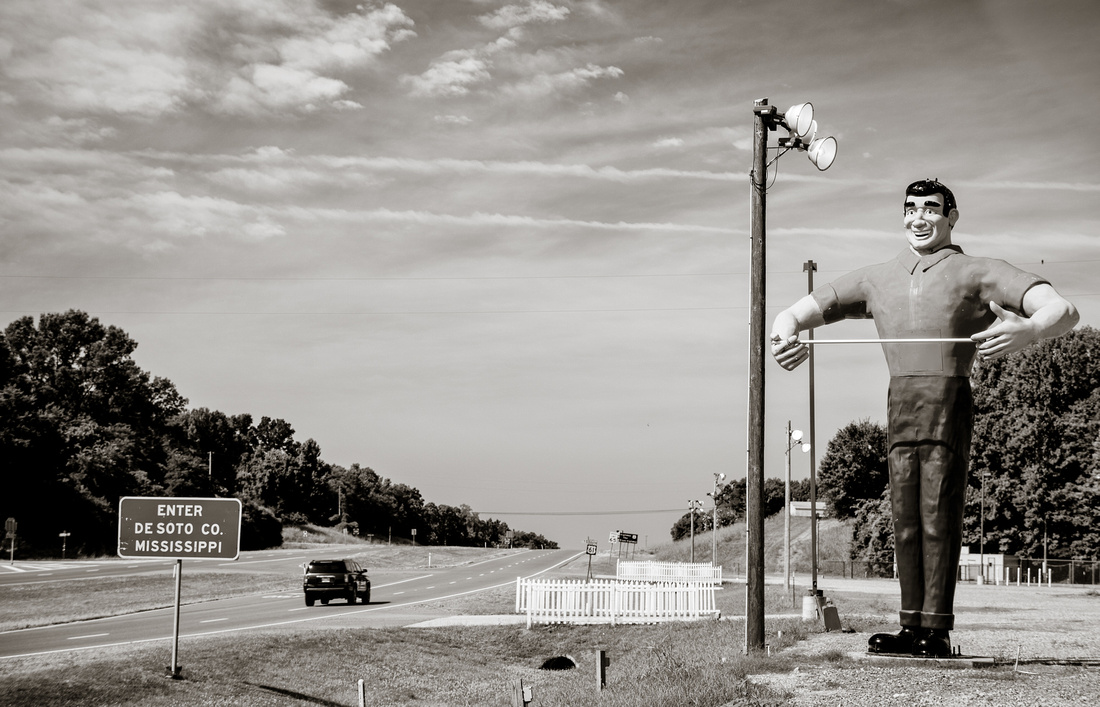
Big John, 2016
There stands Big John firm against the brilliant sky, tall and hollow, alone and happy. He's been there awhile now, along Highway 61 on the outskirts of town. It's hard to say whether he's coming or going. But he's a happy, abandoned relic in the roadside museum of American kitsch.
Yes, there he stands, an empty-armed mascot of a supermarket that once was but is no more. Big John is unburdened now, free of the fiberglass bags of groceries filled with myths that he once carried and free even of the supermarket itself that told him who he was: provider, breadwinner, hardworking family man who brought home the bacon.
A hundred yards to his north sits a boarded-up "gentleman's club," a "strip joint" in the unvarnished vernacular of working class men in blue jeans and tieless shirts like Big John. I wonder if Big John ever feels his hollowness on some of those dark, lonely nights along the Blues highway. I bet he's tempted to stumble in there, imagining himself a supersized Don Juan with a giant fistful of dollar bills in search of intimacy and companionship now that he is out of work and short on self-worth. But alas, his feet are bolted firmly to the ground.
A bit to his south is a fireworks stand where the crowds pull in to buy their freedom by the box. For a few bucks and weeks in midsummer, they can bask again in "the rocket's red glare" while waiting "for the dawn's early light." I wonder if Big John ever wants to swagger over there and light a few Whistling Petes or Roman Candles in the name of liberty, reliving the founding myth of bullets, bombs, and liberty one sparkler at a time. But alas, his feet are bolted firmly to the ground.
A dozen yards to his east is the ramp onto Highway 61, the way out of Dodge. I wonder if, short on work and meaning, lonely and disconnected, and bored with the the rituals of bullets and bombs, Big John ever longs just to "hit the road," to ride off into the sunset like a cowboy in search of a fresh start. But alas, his feet are bolted firmly to the ground.
Being tied down has saved Big John, saved him from himself and saved him for us. Being bolted down isn't so bad. Look, he still smiles and even has shiny shoes. And watching over the endless line of other cowboys on their way out of town seems good for the big soul of this grinning idiot.
Hey cowboy, as you whiz down Highway 61, pay attention to the kitsch. It can teach you more than it ever intended.

Poet, Minstrel, Muse, 2016
The shadow of Plato's Republic falls long across the imagination of western philosophy, theology, and spirituality. In it, Plato offers a vision of the good society centered in reason. In the well ordered polis, Philosopher-Kings and Guardians, attuned to the eternal forms far above the shadowy things of this material world, govern justly and order life benevolently for all.
In Plato's rationally ordered world, everyone has an assigned place, rank, and function. But curiously, the maintenance of this rationally ordered world also requires what Plato calls "a noble lie," a fiction created by the elite Guardians and taught to the masses to convince them to embrace their socially assigned place as natural, reasonable, and inevitable. The noble lie is a falsehood ostensibly generated and enacted in the interest of a greater good. The noble lie was a kind of propaganda that legitimated social rank and function by appealing to the different kinds of metal allegedly found in one's blood from birth. To step out of one's place was to deviate from one's metallic nature, to bend metal in unnatural and dangerous ways. Thus, the conflation of reason and social power were concealed by this "noble lie" internalized by the masses. [1]
What's also interesting is how suspicious Plato is of artists and poets. The good artists are craftspeople who should merely imitate in their art what they see in the world. Imitation rather than interpretation is the artist's calling. And curiously for Plato (but not for Aristotle after him), perceiving artistic beauty should be free of deep pleasure. Apparently, artists were to leave the heavy thinking of interpretation to the Philosopher-Kings, and all pleasure would eventually trickle down to the rest of us from their lofty heights. [2]
Having successfully house broken the visual artists, Plato turns to the poets and decides it better to banish them from his ideal republic. Poets are energized by the muses, those uncontrollable, mischievous agents of creativity with ties to the gods who disrupt things as they are, ignite the imagination to envision something new, different, and maybe even better. Poets traffic in metaphor, paradox, wordplay, lyric, story, riddle, and song, all of which are fraught with ambiguous meanings not easily wrestled to the ground by reason and good order, even when they are armed with the billy club of noble lies. [3]
When politics and community begin in reason but come to depend on noble lies to prop them up, whether in Plato's time or our own, there is cause for deep concern. Perhaps we in the United States have, in the interest of a reasonable and ordered society, embraced our own noble lie. We have asked women, the poor, people of color, Muslims, queer people, alienated working class white folk, and angry unemployed rural men, for example, to accept their marginalized rank and function as natural, inevitable, and reasonable. Our rational society demands the ordering of power and privilege found in the status quo. Embracing the noble lie allows us to render invisible the suffering and injustice masked by reason.
The problem with noble lies is that they are always tenuous, and require the multiplication of more lies to secure themselves. And when noble lies are finally exposed, it brings deep turmoil and struggle. Such well-worn, well-told lies always die a slow, tortured death that brings forth hate, rage, and violence as part of the grief of losing them.
Perhaps the danger of the poets and untamed artists is that they will expose the noble lie and the naked pretenses of reason. Wild-eyed, word-slinging poets might fire the imagination of their hearers toward other possibilities. Metaphors without crisp meaning but charged with evocative power might expose the fragility and limits of reason itself and indict the noble lie. Beauty might not be about mere imitation. Beauty might be about subversion, about new and never-before-imagined possibilities seizing hearts and minds and calling forth radical change. Beauty might trangress and erase the well chalked boundaries that demarcated order and privilege in our polis. Beauty might rescue people from the delusion of rational control and its noble fibs, or it might stir people to die trying. Poets fraternize with revolutionaries. They are always among the first to be purged in totalitarian states.
Plato was right. Poets (and undomesticated artists) are dangerous because they represented a volcanic eruption from beyond the world of rational control and noble lies; poets traffic in surprise and wonder, playfulness and laughter, all of which are subversive. They expose the hidden fissures of reason and in so doing challenge the distribution of social power and the structures of privilege often legitimated by appeals to seamless reason and its noble lies. Art touches mystery and transcendence, evokes new imaginative possibilities for the world, and tangles a robust affirmation of the goodness of the world with an equally robust criticism of the falseness that tries to erase it. Artists love to make visible what is invisible. They love to bend the metal found in earthen mines and fleshly veins into new things.
Perhaps this is part of why we need artists and their creative work so desperately in our own current, conflicted cultural moment where fear is driving us to desperate measures to preserve a status quo that seems ever so rational. But as in Plato's Republic, what's rational often needs a well-crafted, noble lie to prop it up. But even well-crafted, noble lies are dissolved by the beauty of artists and poets, because in the end, the Beautiful is always also the True and the Good.
If it is true that in times like these we most need artists and beauty, then its equally true that in times like these both are often least welcomed. In seasons of social turmoil, we convert art into propaganda, enlisting it strategically for our narrow cause. Unlike genuine art, propaganda dictates a one-dimensional meaning, corralling its sheep toward an overly simplified vision demanding unquestioning loyalty. It is reductionist, strategic, and coercive. Its line from art to action is far too straight and direct. It's clean edges stand false against the real world of jagged-edged ambiguity.
And when art and beauty cannot be enlisted for the cause by the propagandist, they are attacked as bourgeois distractions, escapist forms of sentimentality that make us privileged folk feel good while keeping our distance from the fray and struggle for justice. If art cannot be for us in propaganda, then it must be against us as luxurious, bourgeois escapism.
But the line between art and action is never as straight as the propagandist would like it to be. Nor is it so crooked and labyrinthine as to leave us lost in a dream world of illusion and escape.
Genuine art is far more powerful than propaganda or escapism. Genuine art and beauty work their muse-filled grace on the deep structures of our imagination, opening us to wonder, awe, and previously unconsidered possibilities. They awaken longing for and delight in the particularity of what is seen. When we enter meaningfully and briefly into the strange, new world of a poem or other work of art, we find ourselves delightfully lost there for a while. It has absorbed us the way a good story absorbs a listening child, and in so doing we find that we have joyfully given up our desperate grasp on the world, at least for a little while. Art draws us out of ourselves and away from the petty, acquisitive, self-serving, self-justifying egocentrism that all too often governs our actions, even those so easily cloaked in righteousness and reason.
Long before art issues in particular actions, it shapes our identity, character, and our most basic affective and cognitive attunement to all things. Encounters with beauty and artistry can dissolve the false self governed by anxiety, fear, hatred, and control and awaken a new self attuned to its own creatureliness, the joy of connectedness with all Being, and the longing for and delight that comes from participating in the mystery of life through the ordinary things of life. Long before beauty changes our individual actions and strategies, it changes our identities by rewriting the grand narrative that frames all things and grants them larger meaning.
And now we are back to Plato. Plato did fear the poets because they were propagandists or escapists. He feared them not because they changed actions in the short term or siphoned off our moral energies in escapism. He feared them for the right reason. He feared them because traffickers in beauty can trouble the universe as currently known and arranged. Beauty unsettles and transforms us, deeply, radically, and totally but usually gently, slowly, and seductively. New actions, of course, may and usually do follow upon such deep renovations of consciousness, but they are almost epiphenomenal it. What the poets bring is a revolution of imagination long before there is a revolution of action.
In our age of fear and hatred, desperate messianic politics, terrorism, and the weekly slaughter of those strange, unreasonable "others" aimed at preserving "law and order" and rechalking the lines of conventionality morality and social power, perhaps what we most need is to listen to the poets and artists, and to the gods whose bidding they do.
--------------------------
- Plato, The Republic. Trans. By C.D.C Reeve. (Indianapolis: Hackett, 2004), chapter 3, especially pp. 99-100.
- Kathryn B. Alexander, Saving Beauty: A Theological Aesthetics of Nature (Minneapolis: Fortress Press, 2014), pp. 14-15.
- Cecilia González-Andrieu, Bridge to Wonder: Art as a Gospel of Beauty (Waco: Baylor University Press, 2012), pp. 18-21.
]]>
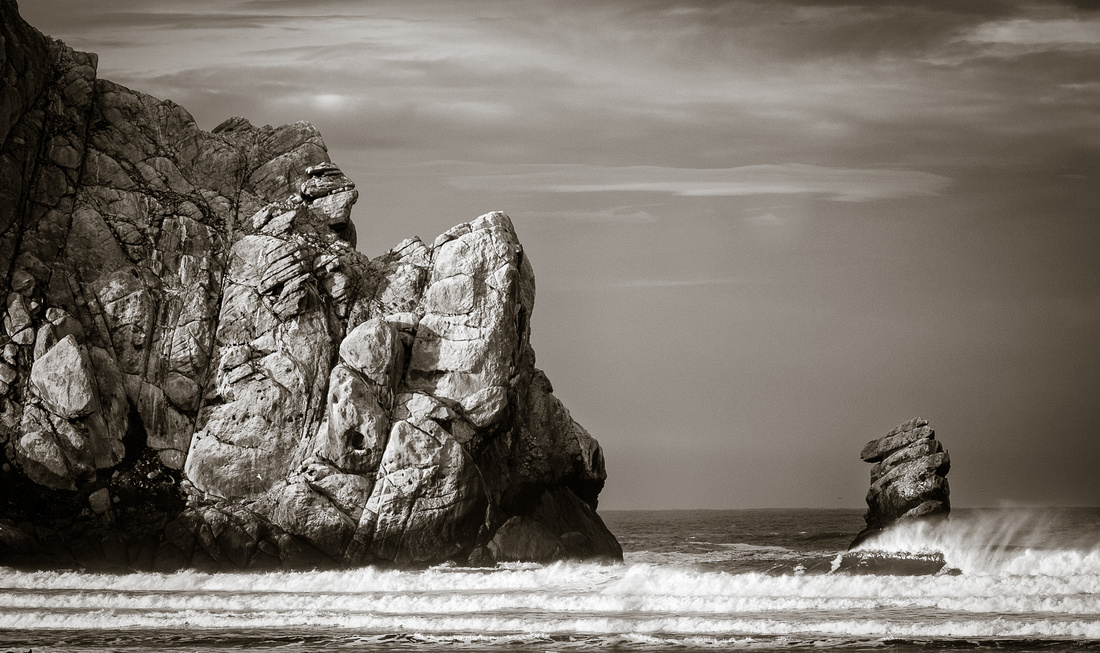
The Point, Morro Rock, 2016
In his wonderful book, From Nature to Creation, theologian Norman Wirzba maintains that "how we name and narrate the world" is determinative for how we position ourselves in and relate to it. [1]
An illustration from Wirzba helps us to see his point. If I hold up before us a plant such as a dandelion and name it flower, we begin to interact with it as a beautiful and fragile thing, bright and fragrant, that pleases the senses. We are tempted to place the bright yellow flower in a vase of water on our dining table to enjoy during meals. It is an adornment worthy of care, attention, and delight.
However, if when holding up the same plant, I name it weed, we immediately see it as the enemy of our well manicured lawn. This weed is far from beautiful and fragrant; it is a nuisance. We don't enjoy it; we want to eradicate it, poison it even, in the interest of a uniformly green lawn.
Or still again, if when holding up the plant, I name it food, we immediately think of adding its leaves to a tossed salad to enrich the flavor. We will savor its slightly bitter contribution to the mix of fresh, delectable summer greens. And if we accept the witness offered by the menus of of fine restaurants, we will regard the consumption of dandelion leaves in our salads as a mark of a sophisticated palette.
Is the plant a thing of delight, an enemy, or a sophisticated food? Will we display, exterminate, or eat it? The choice to name it flower, weed, or food is at the same time a choice to locate it in one of several very different narratives of meaning that dramatically alter our cognitive, affective, and moral response to it. So, yes, "how we name and narrate the world" matters because it shapes dramatically different and often incompatible forms of life in response to it. [2]
In contemporary western civilizations, we name and narrate our world with the vocabulary of consumerism. We name ourselves I and narrate a story in which this isolated, autonomous self is the measure and meaning of reality. We enact our personhood through endless consumption. Other creatures are things, objects or commodities with little or no intrinsic value or sanctity. Things are raw materials waiting to be owned and possessed, used and consumed for my personal aggrandizement. The value of a thing is assigned by us, often by way of a price tag or through some other quantifier of its expendability and benefit to us. The problem with this naming and narration is that the appetite of the naming I is never sated, and we are trapped on a treadmill of utilitarian logic that demands more, bigger, cheaper, and easier. In this story, all creatures other than the self become things stripped of sanctity, lacking inherent worth, and thus unworthy of empathy or moral regard.
Not unlike the great religions of the world, artistic creativity and works of art can provide another way to name the plant. At their best, artists seek to name and narrate the world not as thing but as gift. [3]
Gifts, of course, can be and often are easily co-opted by the naming and narrating strategy of comsumerism. When that happens, they become thinly veiled transactions in which a gift given must be repaid by another gift of equal or greater value so as to balance the ledger of social power. Generosity, so the logic goes, is merely a mask for covertly exacting obligation, favor, or acquiesence from another. Better to pay back the debt to preserve one's autonomy.
But gifts need not become things pulled into the orbit of dominative power. To name the world and its creatures as gifts can to be recognize that all things ultimately come to us from beyond ourselves, including our very lives. Despite our efforts at denial, we are fragile creatures -- finite and radically dependent on realities given to us from beyond for daily survival. Gifts confront us of with the radical givenness of our lives and our utter dependence, moment by moment, on the unconditioned Whence and Whither of our existence. This is why receiving gifts can sometimes feel awkward.
Gifts also remind us of our inescapable interdependence with all other creatures. To give a gift is not simply to give someone a thing; a gift given is a call to membership, a summons to connectedness, and an invitation to deep participation in the mystery of the love and goodness that bind human beings, and indeed all beings, together in ways that are significantly resistant to commodification and market forces. We respond most faithfully to a gift by acknowledging with gratitude that vast web of natural, social, and divine integuments that binds all things together in mutuality and interdependence. Mystery and connectedness, dependence and interdependence, humility and gratitude lie back of and saturate this different economy of gifts. These qualities in turn open us to wonder, thanksgiving, and deep delight -- qualities of soul noticeably suppressed in the economy of things.
When painters daub pigment on a canvas, when sculpters collects bits of driftwood and fashion them into mobiles with string and wire that float in the breeze, when photographers record an ordered composition found amidst an overwhelming surplus of rocks, clouds, and trees, they are offering to themselves and their viewers a gift. Their creative act and piece of art are less an expression of their private inner life and more an invitation to a new imaginative way of naming, narrating, and thus relating to the world and its Source. For a moment, this gift of beauty can arrest our drive toward cognitive mastery and material control. We find ourselves lingering over it in delight, attending to its particularity with wonder, curiosity, puzzlement, and delight. To give up control, to linger, to experience curiosity, puzzlement, wonder, and deep delight are antithetical to the logic of control, efficiency, and utility that govern the cult of the thing.
Good art invites us into a dialogue with itself, and when the dialogue is genuine, it displaced us as the measure of all things. Such an artistic gift is never perfect, but in its own fragmentary way it summons us to see differently, to name and narrate the world in new, graced ways. We can be creatures again who acknowledge and embrace our own fragility and dependence on the universe of being. Ultimately, an experience of artistic beauty is an invitation to membership, connectedness, and participation in an expansive, cosmic community of being. In this community, the logic of scarcity, acquisitiveness, possession, and disposability is overcome by the logic of abundance, communion, mystery, and deep, lasting delight.
------------------------
1. Norman Wirzba, From Nature to Creation: A Christian Vision for Understanding and Loving the World (Grand Rapids: Baker Academic, 2015).
2. Wirzba, pp. 18-19.
3. Wirzba, pp. 144-52. I am borrowing and adapting Wirzba's elaboration of gift. For a fuller discussion of the idea of artistic creativity and works of art as gifts, see also Lewis Hyde's The Gift: Creativity and the Artist in the Modern World (New York: Vintage, 1979).
]]>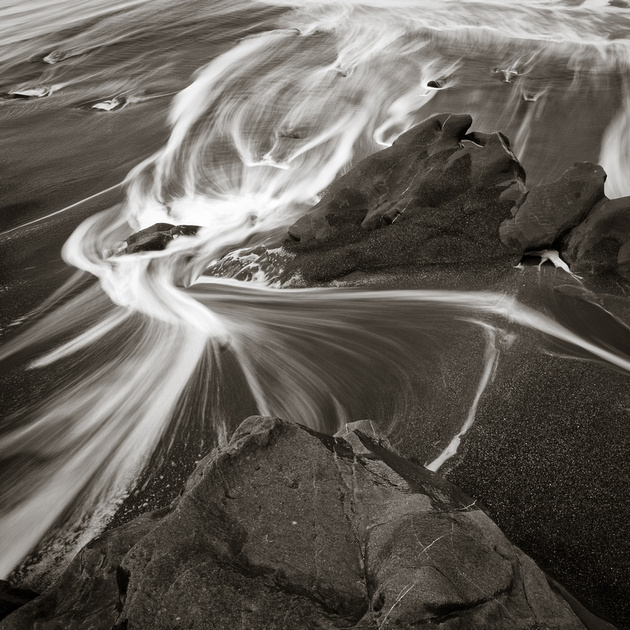
Surf at Moonstone Beach, 2016
|
"… [W]hatever is and whatever comes to be, is and comes to be on account of the beautiful and the good. All things look to it; all things are moved by it; all things are held together by it. Every source…exists for the sake of it, because of it, and in it; simply put, every source, all preservation and all ending, whatever is held in being, derives from the beautiful and the good. Hence, all things must desire, must yearn for, must love the beautiful and the good; because of it and for its sake, the weaker is returned with yearning to the more powerful, equals keep fellowship with equals, the more powerful become providential toward the weaker, and each brings forth itself; everything does and wills whatever it does and wills by desire for the beautiful and the good." --Dionysius the Pseudo-Areopagite, The Divine Names, 4.10, unpublished translation by Kendra G. Hotz
|
In the writings of the sixth-century Christian mystic known as the Pseudo-Dionysius (or "Denys"), we find a suggestive vision of the human condition. When Denys surveyed the human landscape, he concluded that our condition is one marked by a fragmentation and restlessness that undermine stable, integrated personhood. The tragedy of our condition resides not so much in disobedience and guilt but in pervasively distorted desire. To be human is to be an erotic being, where eros refers not primarily to sexuality but to the integrative pattern of yearning and desire that draws together our identities and orients us to all reality. Denys claims that before our fall into this tragic state, the desire that constitutes our personhood was like a single mirror that reflected a unified vision of life focused on the Divine. This singularity of focus ordered our identity so that the various desires of the soul and body were brought into homeostatic balance and harmony, ensuring, for example, that our sexual desire, our desire for food, our desire for companionship, our desire for work, our desire to own, use, and enjoy things, and our desire for God, were integrated into a carefully orchestrated, interdependent unity that brought wholeness, beauty, and harmony to all of life.
The Fall shattered that mirror into thousands of disconnected shards, each reflecting a diverse, discrete object of desire. A unified, integrated self became a fragmented, dislocated self drifting anxiously among a variety of disconnected things desperately investing each of them with an ultimacy that none of them could bear. The tragic consequence of this is not primarily guilt but personal disintegration, chaotic restlessness, contradictory and confused desires, alienation from self, and exile from the world of authentic relationships with God and others.
What has come to interest me as a theologian and photographic artist is the way that consumerism as the prevailing meaning-making system of our world reflects and answers to this ancient theology. Consumerism is more than an economic system. It is the totalizing ideology or, if theologian John Kavanaugh is right, the prevailing religion, of American life that has soaked deeply into our bones, shaping our individual and communal perceptions, values, actions, and assumptions in ways we usually remain blind to.*
Consumerism depends on the fragmentation and distortion of our desire, the elusiveness of fulfillment, the addiction-producing ache of incompleteness, and the illusion that finite objects will do for us what only the Infinite can do. To produce, buy, and consume are its ethical mandate. Competition, possession, and egocentrism are its cardinal virtues. Shopping is salvific, and cheap, fast, and convenient are the tropes of its over-marketed liturgy. More is its great eschatological hope and Santa Claus its patron saint.
A constant stream of new and improved products are paraded before us, each promising to do for us what the last one failed to do. Each reminds us of our insufficiency even as it offers a faux redemption from it coated with ersatz ultimacy. Infiniti is yours as a luxury sedan made by Nissan, and Eternity is bottled as a $42 cologne by Calvin Klein. Buy her earrings from De Beers Jewelry and like the silhouetted selves in the televised commercial you and your beloved will slip into the dark bedroom lit only by the sparkle of diamonds and rediscover your lost intimacy, sexual passion, and marital concord. You'll be a real man again, a provider for your woman, and she'll rediscover the power of things to narcotize the pain and diminishment of selfhood required by patriarchy.
I am more and more convinced that the pursuit of creativity and beauty in the arts can be one of the ways back to a unified, concentrated form of desire where integration overcomes fragmentation. Like prayer, sacraments, and other contemplative practices, artistic creativity and viewing works of art can become effective, albeit clumsy, efforts at coherence, wholeness, and connectedness in a consumerist world governed by divided desires, transient allegiances, and false objects of ultimacy. To be sure, efforts at creativity and beauty can be and often have been co-opted by consumerism, but at there best, they can form part of our strategy for resistance and the rediscovery of wholeness, well ordered living, and authenticity.
Artistic creativity and the thirst for beauty emerge out of an ordinary person's longing for connectedness and coherence, out of a longing to discern and bear witness to a larger underlying unity capable of stitching the fragmentary episodes of our individual and shared lives into a single, grand epic penned by that mysterious Other "in whom we live, move, and have our being." Art and beauty are an invitation to see, hear, touch, move, and ultimately live differently.
Good photographs or other good works of art can serve as portals through which we briefly glimpse the primordial unity that upholds and expresses itself through all things. But even this glimpse, brief, distant and oblique as it is, is enough to teach us that beauty is not simply there to entertain us. It is there to restore us, to occasion both the reintegration of the self and our reconciliation with others and with the Wholly Other that always seem to elude us in the fragmenting world of consumerism. Beauty has this power because it is ontologically real and because it is a concretization of divine grace.
Artistic creativity can be a gesture, albeit a halting, partial, and clumsy one, that points us toward the simple truth that beauty is Gospel spilled lavishly on the world.
-----------------------------------------
*John F. Kavanaugh, Following Christ in a Consumer Society: The Spirituality of Cultural Resistance (25th Anniversary Edition, New York: Orbis Books, 2006)
]]>
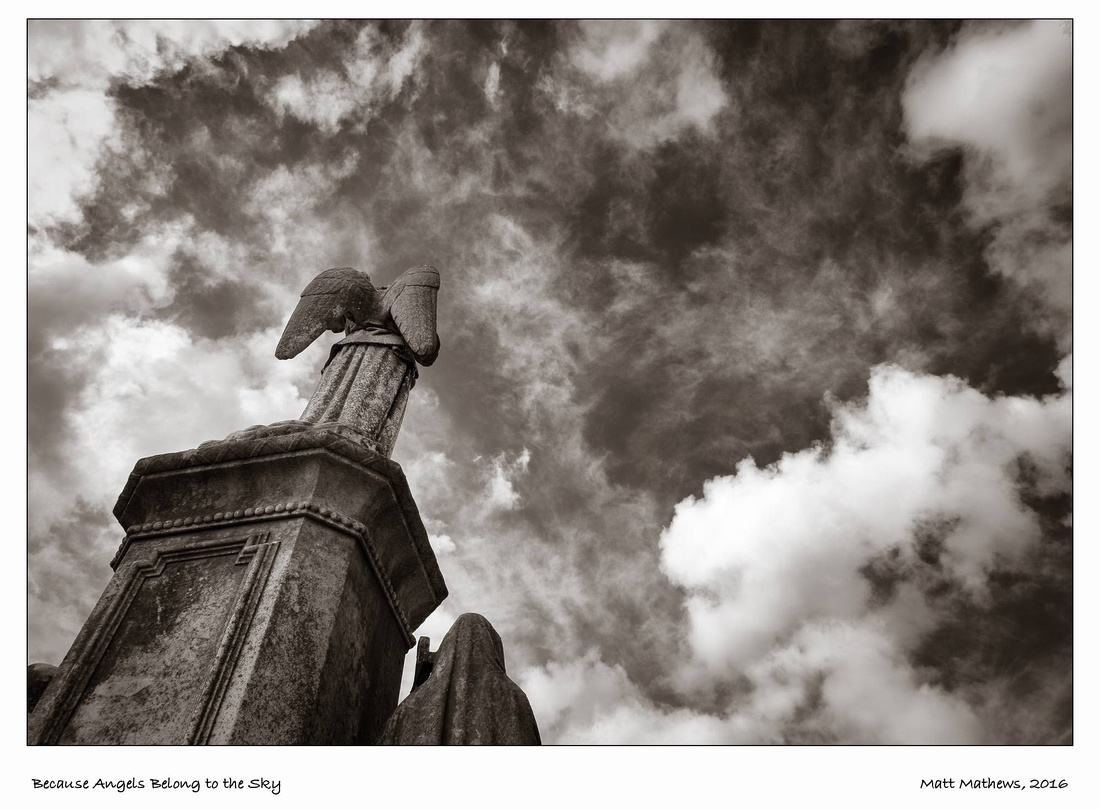
During 2016, I am serving as the David McCrosky Photographer-in-Residence at historic Elmwood Cemetery in Memphis, Tennessee. I have photographed at Elmwood for many years, but not with the frequency or intensity that now accompany my role there.
Elmwood Cemetery is many things. It is the resting place of countless citizens of the city, many of whom shaped its life deeply and even more who did not. This is no indictment of the latter, but its own kind of praise.
When I walk among the eighty acres of statuary at Elmwood, I find myself pulled in two directions. I am first drawn to the large, exotic statuary inflected with a heavy Victorian accent -- towering angels, childlike cherubs, angelic nymphs, stern-faced busts, inscriptions of florid prose and sacred verse. There is even a lexicon of symbols, garlands, flowers, obelisks, pillars, and cisterns that translate into stone the nineteenth-century language of death. It is a beautiful sight to behold, and a photographer's playground.
And yet, there is another side to walking at Elmwood that draws me as well. It involves seeing the gravestones of the average people, the ordinary folk whose graves are easily overlooked amid the extravagance of the Victorian garden with its hovering flock of angels. These are the gravestones of infants and children, often small and nameless, bearing only the word, daughter or son, or in some cases, only two initials. And then there are other gravestones, many broken and fallen, whose letters have become unreadable, worn smooth and indistinct by a hundred or more years of weather. And still again, there are the more recent, plain gravestones bearing only names and dates, as noticeably short on sentiment as they are on aesthetic appeal. It is easy to walk past these rather plain, functional memorials in search of the angels, generals, mayors, Civil War soldiers, Memphis's first black millionaire, and the martyred Episcopal nuns of the yellow fever epidemic of 1878.
This visual tension created by the variety of memorials awakens ambivalence in me. The most ornate gravestones and memorials are there to coach our memory about the people at rest beneath them. Such coaching, of course, is as notoriously lopsided as the markers themselves, many of which, like little leaning Towers of Pisa, have settled with time and now stand awkward and crooked. If we are honest, we know that these folk were not as angelic as the stonework above them suggests. They trafficked as much in power as in virtue. And yet, we or their loved ones prefer to re-remember them angelically, at least for awhile, until grief is far enough distant to allow for honesty.
But then there are those ordinary markers of the average folk, the graves of a sort of blue-collar dead people. Their gravestones coach us less, leaving us only with naked facts, a name with only the dates of birth and death etched artlessly on unadorned stones that look mass produced. Perhaps these are the more honest memorials, seeking only to mark an ordinary life lived and lost. They make no bid at angelic re-remembering. There is no effort to win for the ones below a redemption from all ambiguity and ordinariness. Unlike the large crypts and towering memorials that punctuate the cemetery around them, these smaller, plain markers seem to make no claim at immortality through stone. But surely, the lives of those beneath them were as full as the lives of the white-collar dead people who seem to hold them hostage in the cemetery. Surely their loves were as deep, their hopes as intense, their joys as real, their suffering as intense, and their families as important as those of the angels.
When I walk and photograph at Elmwood, I am drawn to both kinds of markers. As a photographer, I am drawn to the memorials adorned in Victorian excess, desperately seeking to coach our memory of the dead and achieve for them a kind of immortality in stone. I need them because I know that the same longing for recognition and permanence and the same temptation toward antiseptic memory well up in every human heart, my own included. As a theologian, I am drawn to the plain markers of the average people, for they offer a more realistic assessment of our days and lives. There is no attempt to accomplish in stone what they did not accomplish in life. They lived and loved, worked and played, and celebrated and lamented like I do. And then they died. And so will I.
As lovely as the angels are, we are not them. We belong to the earth below with all of the ambiguities, possibilities, and partialities ingredient in ordinary flesh.
In the end, it is only the angels who belong to the sky.
]]>
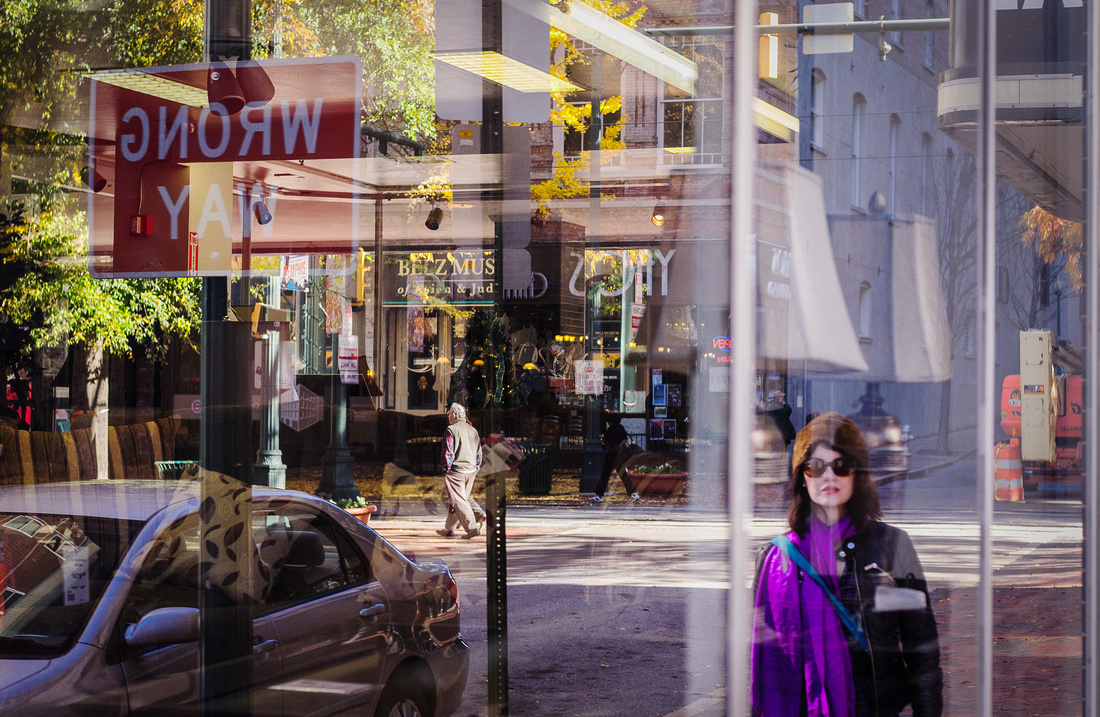 "Our hearts are restless until they find their rest in thee, O God."
"Our hearts are restless until they find their rest in thee, O God."
-Augustine, Confessions, Bk. 1, Ch. 1.
"...[A]s [the human] will is attracted or repelled by the variety of things..., so is it changed or converted..."
-Augustine, The City of God, Bk. 14, Ch. 6.
Human beings are shot through with desire. We hunger and thirst, ache for companionship and burn with sexual desire, and we long for things, some good, some bad, most a tangle of both. Augustine knew that human beings do not merely have desires; we become what we desire. The objects of our desire shape us into the kinds of people we become. What we desire hones our attention and forms our habits, blinding us to some things, highlighting others. How we see, what we see, and who we become are intimately and complexly commingled. So, while it is true that we have desires; it is perhaps more true to say that our desires have us. We become what we desire.
The windows along Main Street are intimately connected to this economy of human desire. In them we see things and promised experiences vying for our dollars, time, and loyalty. The carefully arranged tableaus and mannequins, collections of curios, well chosen words, and price tags are not simply selling things; they are seducing us with a vision of fully satisfied human desire.
The windows offer a kind of ersatz salvation, and much of the power of consumerism lies precisely here. While it purports simply to be meeting our desires, consumerism in fact creates those desires, shaping and reshaping them ever anew by holding before us an endless array of new and improved things to be easily acquired. The power of consumerism is not so much that it offers an array of things to satisfy our natural desires for food, shelter, clothing, recreation, and companionship. Rather, the power of consumerism resides in its capacity to redirect and exaggerate these desires by attaching them to things that have been imaginatively resignified to become bearers of an elusive but powerful vision of perfect human fulfillment.
While consumerism promises perfect fulfillment, that after all accounts for its irrestibility, it in fact depends upon the continued disappointment with the things we already own to fuel a fresh and even more intense desire to acquire the latest things. Buying the lingerie found on unrealistically lithe mannequins in boutique windows will make your body desirable again in his eyes. You will be young again. You will be thin again. You will be loved again. Buying the oversized truck found in the walk-in windows at the dealership and advertised with the deep, husky male voice in the electronic window on your living room wall will settle questions about your masculinity. You'll be man enough for her. You will be loved again. Buy the larger home pictured in the windows of the real estate office and fill it with this season's newest furnishings from the furniture store windows, and your family will know domestic bliss, and your neighbors will know your social worth. Order from the menu in the window of the trendy restaurant or buy her a diamond from the jewelry case, and the spark of romance and sexual excitement will return.
While the windows of Main Street proclaim a carefully marketed gospel of commodified desire, these same windows are engaged in a silent rebellion. If you look at them rather than through them, if you look at the play of reflections with their odd juxtaposition of elements from the street that superimpose themselves upon the carefully choreographed tableaus of the marketers, you see their silent rebellion. Street signs, blurred faces with unguarded expressions, inverted words, cars, pavement, paint, and foreign signage crash disruptively into the carefully planned, controlled scenes behind the glass. Sunlight glints unpredictably and the changing play of clouds and sky appear and reappear unpredictably minute by minute. If you pay attention to the reflections, you can too easily overlook the message behind the glass. And when that happens, the windows have won their rebellion.
Despite every attempt to control what we see in them, and despite every attempt to create and direct our desire through what is seen in them, the windows won't fully cooperate. In the play of reflections, we find accidental beauty, visual riddles replacing the marketer's confident slogans, indeterminate visual possibilities that can free our imagination and liberate desire from the lie of owned things.
Yes, the windows are engaged in a silent rebellion against those who would control them, and through them, control us.
]]> Pottery and Shard, Madrid, New Mexico, 2011
Pottery and Shard, Madrid, New Mexico, 2011
In the sixteenth-century writings of the Jewish mystic, Rabbi Isaac Luria Safed (1534-72) there is an intriguing creation story known as "The Shattering of the Vessels."
God, the story goes, created the world by pouring primordial, divine light into ten fragile vessels that would become the world. The primordial light -- the bearer of all beauty, goodness, and righteousness -- however, was simply too much for the fragile vessels, and they shattered into many shards, scattering their light into the world as innumerable sparks. These fragments of light are often hidden among the clay shards, held in bondage by the suffering and brokenness of the world. God then created human beings for the purpose of gathering up all the sparks of divine light scattered to the four corners of the earth. The good Jew is called to seek out and liberate the sparks of primordial light that bear God's presence in the world. To do so, is to pursue tikkun olam, "the repair or healing of the world."*
In this Kabbalist tradition, we find a powerful metaphor not only for faithful living but for creative photography. The metaphor suggests at least three things, the first about the object of our interest, the second about the impulse to create, and the third about the power of the beauty ingredient in resplendent light.
Photographic creativity is about searching out the delicate, scattered fragments of light that have already spilled into the world. This beauty is already there. You just have to find it. It's not in the eye of the beholder. It's in the nature of things. A photograph is a good one to the extent that it bears witness to those often overlooked but always given fragments of splendorous light already in the world. Photographs are invitations to liberate these sparks of light from bondage to the stale, habituated, hurried ways of seeing that conceal them from us.
But why do photographers search out these fragments of light? We do so not merely to make a beautiful image that pleases the viewer. We seek something deeper than the viewer's pleasure and approval. Photographs aim at a greater end, "the repair and healing of the world." Creativity is our attempt, often halting and always partial, to touch something real and outside of ourselves and to be healed by it. The creative gesture is also an invitation to others to touch it and be healed as well.
Artistic pursuit is thus not about a tortured artist expressing some fictional inner genius, inflicting the vagaries of her or his tumultuous inner life on the rest of us. Nor is it about creating pretty pieces to hang as ornaments on the wall above the sofa. Rather, the artistic pursuit of beauty reveals a longing for connectedness with the primordial light that is the source and end of all things. Creativity is at once the artist's own attempt and invitation for others to participate in the wholeness, restoration, and healing that lies at the heart of the world. To know the beauty of the light is to experience oneself as part of something much larger and infinitely more interesting than oneself. To experience such beauty, or better, to soak in it over time, is to live proleptically into wholeness, participating in the unifying power that creates, sustains, and directs all that is.
To experience the beauty made possible by resplendent light is both unsettling and liberating, troubling and reassuring. It is unsettling and troubling because having dwelt in its midst, we can no longer casually overlook the brokenness of our world that hides its sparks. We sense the unsettling dissonance between the fragments of light and all that conspires to conceal them. Contemplation flows into action, but an action that always returns again to the contemplation of the liberating, reassuring light that saturates all things.
-------------------------------
*http://www.tikkun.org/nextgen/how-the-ari-created-a-myth-and-transformed-judaism
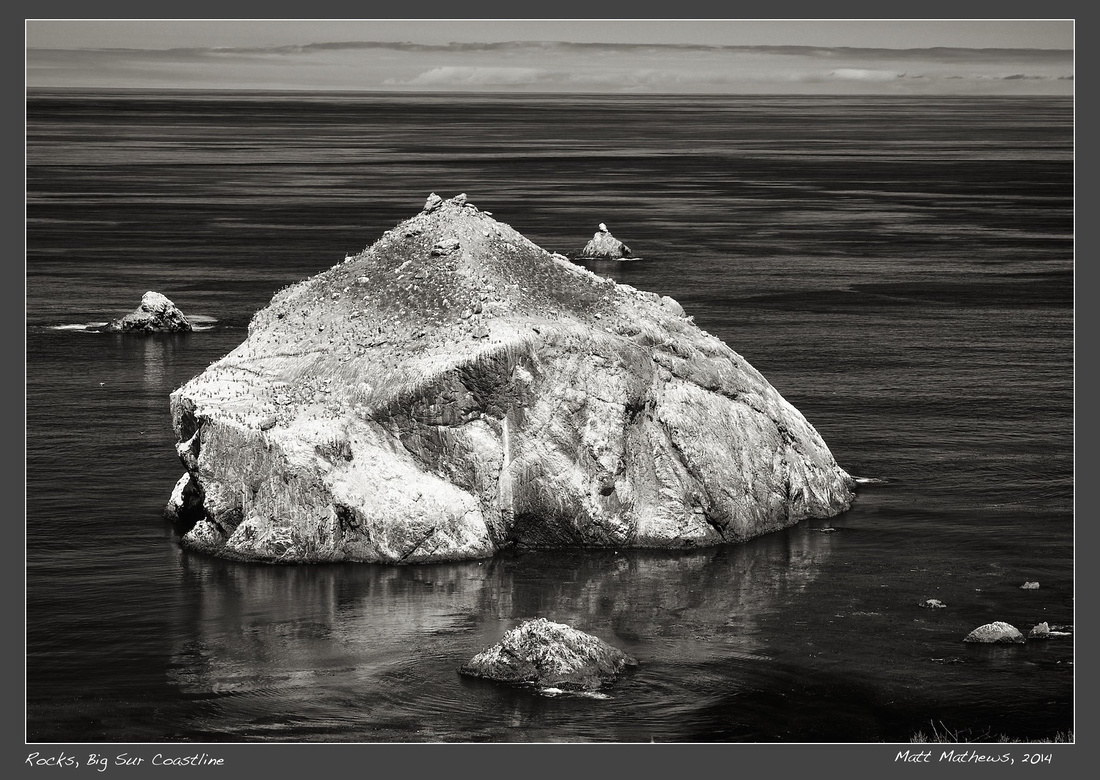
Amidst the Great Depression and rise of fascism in the 1930s, the French social documentary photographer, Henri Cartier-Bresson criticized Ansel Adams for neglecting to photograph the social crises of the day. "The world," he said, "is going to pieces, and Adams...[is] photographing rocks and trees."*
Cartier-Bresson was right about the world in the second quarter of the twentieth century. It was coming unraveled. The United States was in the depths of the Great Depression and staggering rates of unemployment, long soup lines, and widespread homelessness seemed overwhelming. Even the land was in exile, with its fertile topsoil carried off by the winds of the Dust Bowl. For many, the American dream seemed a lie, and it lost its mythic power over their imaginations.
Fascism was on the rise in Germany, Italy, and Japan, and a second world war seemed merely a matter of time. The Ku Klux Klan was at its height in the United States, and with it came unparalleled numbers of brutal lynchings and institutionalized racial violence. A good bit of Cartier-Bresson's own groundbreaking social documentary photography would depict this world governed by fear, violence, scarcity, social dislocation, and racial animus.
If Cartier-Bresson was right about the world, he was wrong about Adams. Adams was not insensitive to the social realities unfolding around him. He felt them keenly. But he kept on photographing rocks. "We need a little earth to stand on," Adams said, "and feel run through our fingers."* Adams knew that there was a deeper reality beneath the fears and immediate crises of the day, a deeper beauty resident in the natural world, and that contact with it was essential to human flourishing, essential to what the wild-eyed apocalypticist called "the healing of the nations."** Tempting as it was to turn his camera in service of social and political movements of the day, Adams kept it trained upon rocks, trees, lakes, and snowstorms because he knew that there was a healing power in natural beauty, a power that connected us with primordial goodness, hope, and receptivity to the mystery and giftedness of all things. To experience such beauty was to feel in one's gut the cosmic benevolent goodness disposed toward life, justice, and the harmonious existence of all beings.
Without the healing balm of beauty, the energy of social activism would flash bright but emit no heat. Or worse, it would get fused with the bitterness and blind self-righteousness that often imperil zealous do-gooders. To neglect this beauty was to neglect the ontological grounding of all being, even if this neglect clothed itself attractively in the immediate gratification that can come from social activism and art for a political cause. Adams knew that ethics needs metaphysics; that the pursuit of the True and the Good must always also be the pursuit of the Beautiful at the same time.
Adams's was not a call to an aesthetic escapism but rather to groundedness, to the cultivation of the soul, and to a connectedness with natural beauty that issues in life, joy, and gratitude. These experiences leave less room for the chronic anger, bitterness, and cynicism that threaten to engulf us in an age of violence, fear, and racism.
In our contemporary world so similar to the one described by Cartier-Bresson, we would do well to pause and linger with Adams's insight. His was not a call to quietism. He did, after all, photograph the Manzanar Internment Camp and the Japanese American citizens imprisoned there by racist fear masquerading as national security, and he released those photos into the public domain to express his moral outrage and elicit it from Americans. He was also a key figure in advancing the cause of early environmentalism, writing thousands of letters to politicians and editors of newspapers. But in the end, for Adams, the social world was grounded in the natural world, and we fail to see this at our spiritual peril.
Social activists, the victims of injustice and violence, and the morally indifferent must all look at the rocks from time to time. Out of the depths of their mysterious beauty might come the transforming grace that will rescue all of us from self-righteousness and alienation. Out of the rocks may come "the healing of the nations."
____________________
*Quoted in "Ansel Adams: A Documentary Film". Produced by Ric Burns in conjunction with PBS's American Experience Series. Transcript available at http://www.pbs.org/wgbh/amex/ansel/filmmore/pt.html.
**Revelation 22:2
]]>
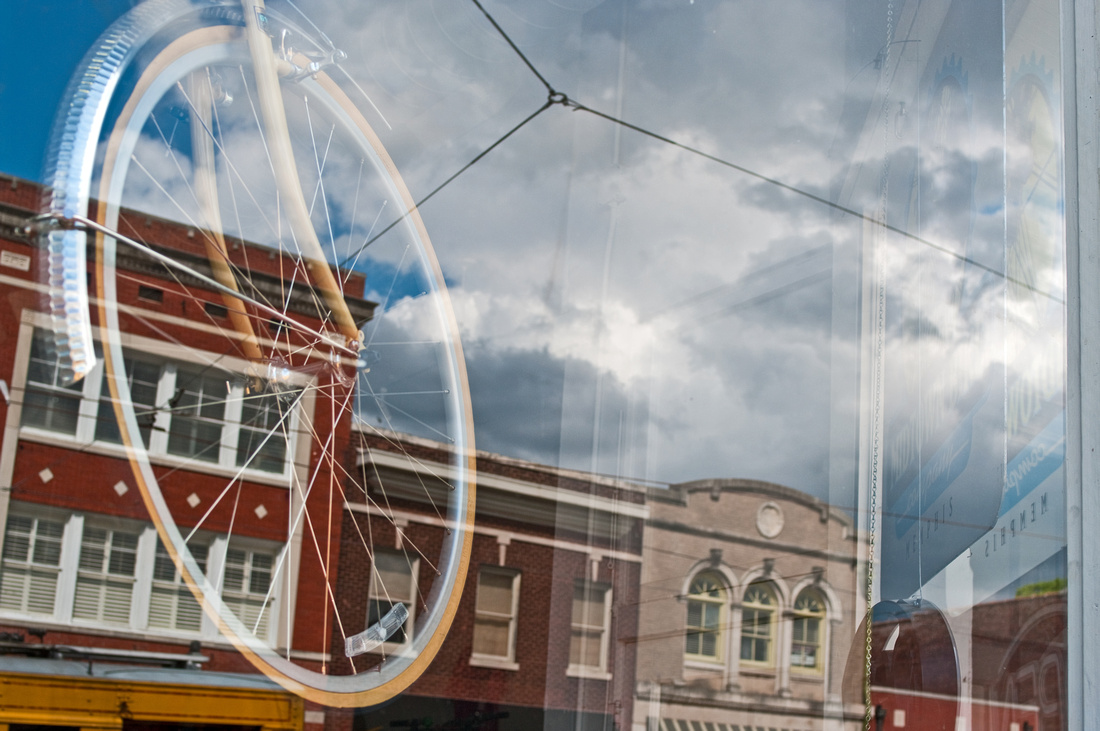 Wheel in the Sky, 2010
Wheel in the Sky, 2010
For the better part of the last decade, I have been photographing on and near Main Street in downtown Memphis, Tennessee. When I began photographing there, I wasn't clear what I was trying to communicate.
In discussing his own photography, Sam Abell has remarked that he often finds that he photographs "ahead of himself;" that is, his visual instincts and creativity impulses lead him out into the world to make photographs of particular subjects before he can understand or articulate why. I believe he's right; I, too, often photograph ahead of myself. Only later do I find words to explore what I was up to with the camera.
My attention has gradually settled on the kaleidoscopic reflections found in storefront windows. As these reflections mingle with the interior spaces and objects behind the glass, the scenes become intriguing, beautiful even, with their odd play of vibrant colors and juxtaposed elements. The scenes are often reminiscent of the surrealistic paintings of Salvador Dali or the collages of school children.
Wheel in the Sky represents one of my earliest moments of insight into the windows project. It was made on a winter day in 2010, and grey storm clouds were giving way to blue skies. As I looked up at a bicycle suspended in the window of a shop, I saw more than a bicycle. I saw an odd intermingling of nature and artifice, clouds and machine, bricks and blue sky. I sensed the oddity of it as well as its peculiar beauty.
Like other photographs in the collection, Wheel in the Sky offers resistance to our ordinary, habituated ways of seeing. We are trained to peer through windows to see what lies beyond, to home in on what really matters. Ours is a penetrating gaze that is quick to discard the ephemera in search of what is solid, stable, and fixed. It is a serious seeing, a seeing with purpose. Things are quickly sized up for their utility or market value. Our visual habits betray our drive for mastery, control, and use. These same habits also betray our casual disregard for wonder, intrigue, and curiosity and our neglect of that felt sense of mystery that wells up within us in the presence of surprising, transient beauty.
In the windows, things are tangled in reflections that are ungraspable, useless, and immaterial. The scenes are riddled with insubstantial forms, and they extol mere appearances above hard realities. Mastery yields to mystery, the practical to the imaginative, and possession to delight. They call for and awaken cognitive flexibility, a spiritual agility that bends gracefully toward wonder, curiosity, and openness.
And in the end, this cognitive flexibility, together with its attendant virtues of soul, may be a vital part of what rescues us from the rigidity, bitter alienation, and xenophobia that seem to animate a new strain of American fascism.
Welcome surprises and savor the strange. Look at the windows rather than through them from time to time.
]]>
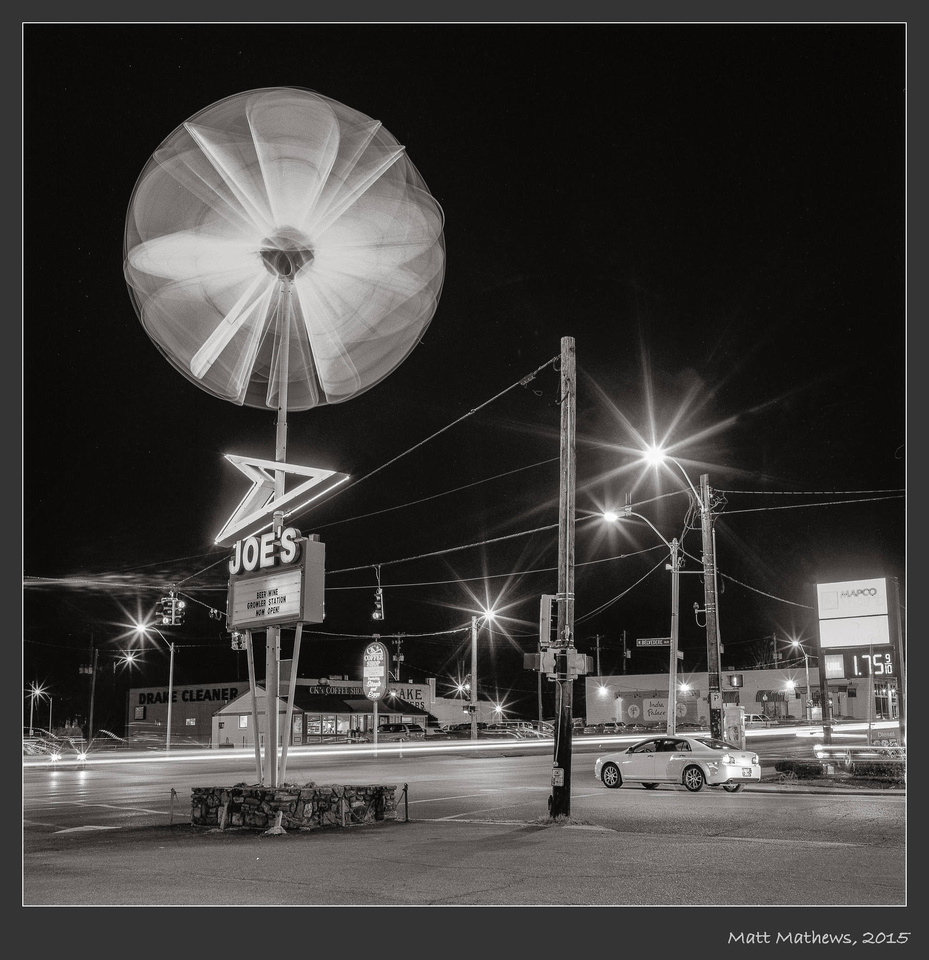
In anticipation of the holidays, I'm announcing the availability of prints from my "Memphis by Night" Collection. If you would like to purchase a print, please contact me ([email protected]). Please identify the photograph(s) you would like to purchase using the thumbnail number(s) visible in the online gallery.
I am offering the following purchase options for these open-edition, signed prints.
Large Prints
Mounted and matted unframed print for a standard 16"x20" frame: $75.00 (actual print sizes is 11.25"x11.25")
Mounted and matted print framed in either a 16"x20" or 18"x24" black gallery-style frame: $150.00 (actual print sizes are 11.25"x11.25" or 13.25"x13.25")
Small Prints
Mounted and matted unframed print for a standard 11"x14" frame: $40.00 (actual print size is approximately 7.75"x 7.75")
Mounted and matted framed print in an 11"x14" black gallery-style frame: $75.00 (actual print size is 7.75"x7.75")
Please allow 10 days for delivery. Order deadline for delivery by Christmas is December 15.
If your order requires shipping, I will simply add only the actual cost of shipping. Add an additional 5 business days to delivery time.
Finally, if there is a print from a different collection in my gallery that you'd like, I'd also be happy to do one for you at the prices listed above.
]]>
The Artist Reception is Tuesday, August 25 from 5:30-7:00pm and is free and open to the public.
]]>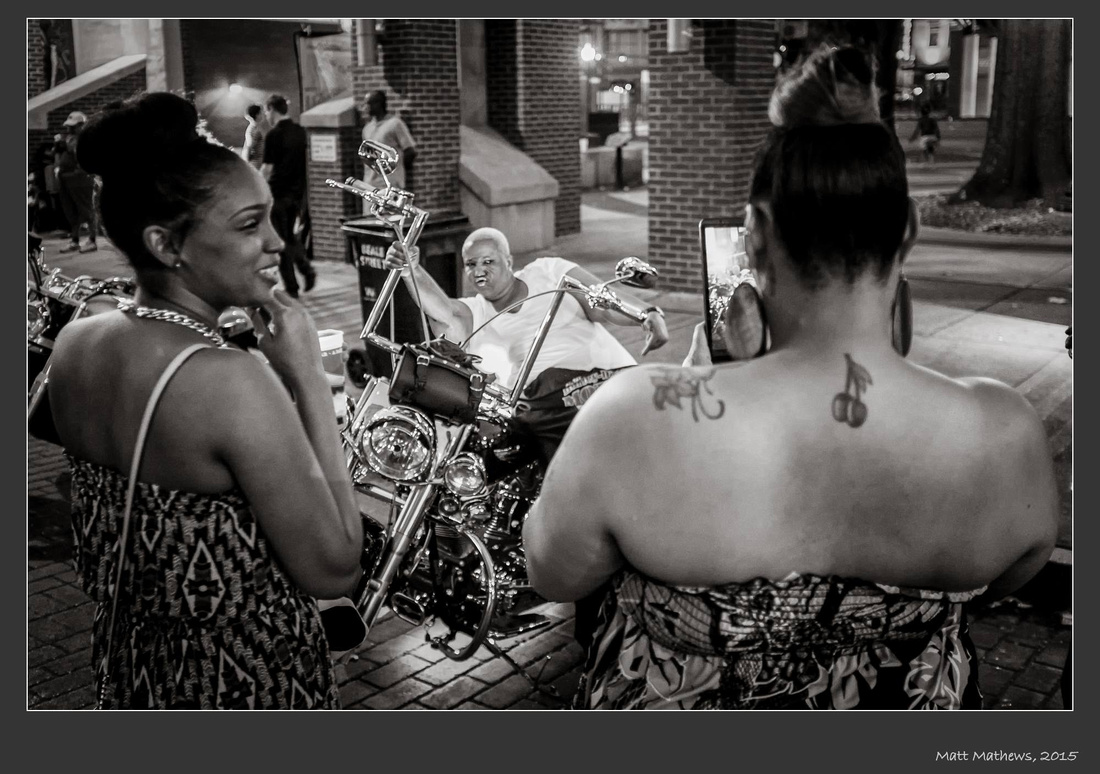
Funk on Beale Street, 2015
I will never understand what it means to be a black woman in America, at least not fully. And I am not alone. But this fact does not exempt me from the obligation to try. Nor does it mean that I cannot come to understand at least something about it if I try really hard.
In Shoes That Fit Our Feet: Sources for a Constructive Black Theology (Orbis, 1999), Dwight Hopkins explores two polarities that exert a powerful influence on the lives of many African-American women. Borrowing from the colloquial discourse of black women, Hopkins names these polarities thing and funk.
Thing names all the forces of American culture that conspire to objectify black women, that work to erase their humanity and render them invisible except when we need them present to be exploited economically, sexually, and culturally. Thing happens when the ideology of whiteness constructs a black woman's identity into an over-sexed exotic other, a welfare queen, or a asexual Aunt Jemima whose nannying is as simple and sweet as tasty syrup on pancakes. Thing happens when we are unable or unwilling to see the myriad of successful black women who disrupt these cultural constructions. And thing happens when we explain away the success of such women as exceptional and thus anomalous, forgetting their names even as we make them "a credit to their race."
It's easy to internalize thing's lie. Toni Morrison and Alice Walker have taught us as much in The Bluest Eye and The Color Purple. The internalized lie shows itself in guilt, self-doubt, and a sense of defilement that wear away at the bodies and souls of black women. A healthy sense of one's worthiness and an appropriate love of self are paralyzed by the venom of shame and a sense of powerlessness.
Funk is hard for white people like me to understand. It seems so loud, so boistorous, and, well, just so black. It makes us uncomfortable. It does so because it protests and resists the stranglehold of our whiteness. Funk erupts in gesture, dialect, slang, art, and in the occasional wagging of a black women's finger at a condescending clerk, nurse, or theologian. Its roots are deep, reaching back to "sassing" the master on the plantation. It was and is resistance to thing. It is a stubborn insistence on somebodyness; a refusal to conform to white expectations for black being. It is soul. It is agency. It is an assertion of her genuine self over against the false constructions of her identity as welfare queen, over-sexed exotic other, and benign nanny. Funk is gospel, grace, and judgment wrapped into one.
But funk is protest in the form of a zesty celebration of life. It celebrates embodiment and soulful sexuality, redeeming them from white fantasy, fear, and violence. It celebrates slang, gesture, and rhythm, offering redemption from "respectable" speech and the politics of respectability required by thing.
Funk is fun. Funk is playful. Funk is parody. Funk piles atop male motorcycles and strikes an overdone, playful pose of parodied seduction and satirized femininity that unmasks the absurdity of our dangerous cultural myths. It's the exuberant, unpoliced celebration of the whole self as it triumphs over thing. If thing is death, funk is life.
Hopkins has helped me understand a thing or two about the experience of many African-American women. I don't fully understand, of course. And, if I'm honest, funk still sometimes makes me squirm a little. It's difficult to confront my complicity in thing as an upper middle class white man. It's much easier to deny thing's existence, insisting on the tired tropes of the importance of personal virtue and hard work abstracted from historical and social analysis. But it's even more difficult to muster some funk of my own to resist it.
In the end, Funk on Beale Street is an invitation "to play that funky music, white boy"* and by so doing deliver my white pigment from the ideology of whiteness that often enslaves it in its own kind of soulless thing.
-----------------------------
*"Play that Funky Music" was written by Rob Parissi and first performed by the band Wild Cherry in 1976.
]]>
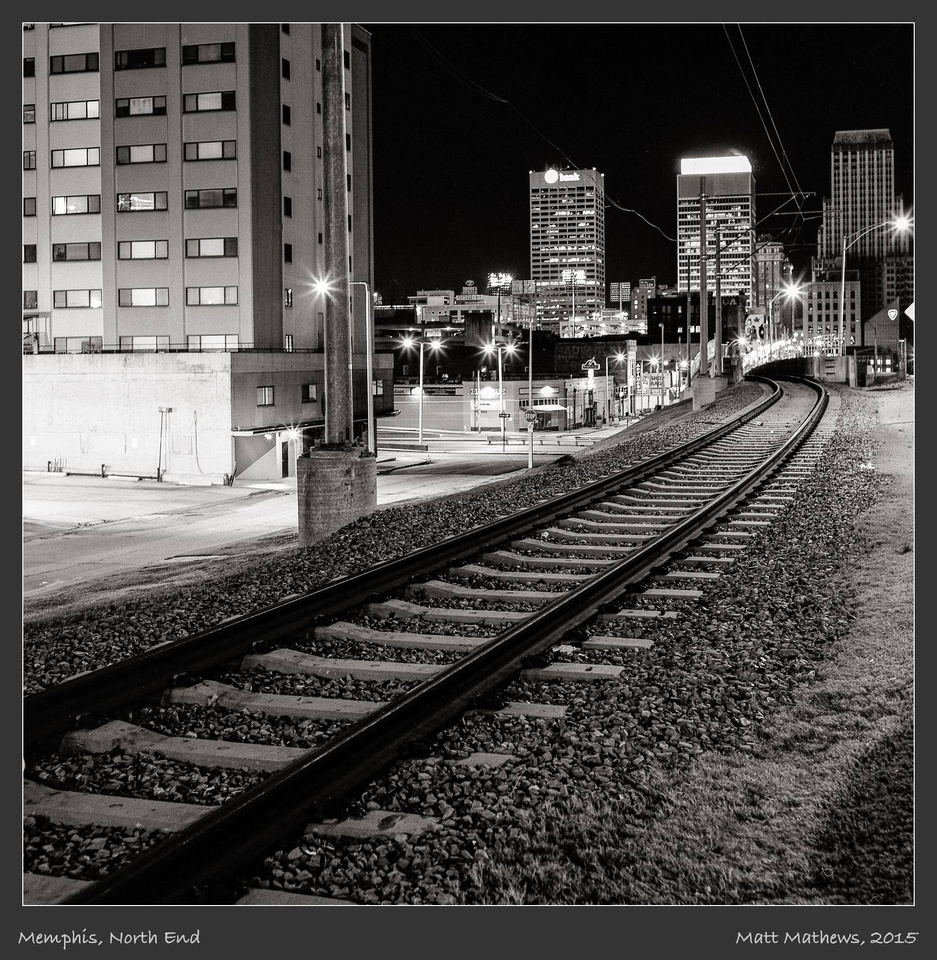
My current photography project, "Memphis by Night," is inspired by Brassaï, the great Hungarian photographer who photographed Paris at night in the early 1930s and eventually published a collection of these photographs as Paris by Night in 1932.
Paris had installed its first gas-lit street lights in 1828, the first city to do so, and with them Parisians redeemed the night for public life. Wandering the "City of Light" at night, usually alone but occasional with a friend or two, Brassaï grew fascinated by the dramatically different appearance of the city. The moody shadows, the uneven lighting created by street lights playing on surfaces of buildings and streets, and the moody, misty light diffused by fog captivated him. In the night, even the small public toilet kiosks that were then common fixtures along Parisian streets seemed like little enchanted castles. With them, the cobblestones, trees, and park benches became a dreamy, noir tableau.
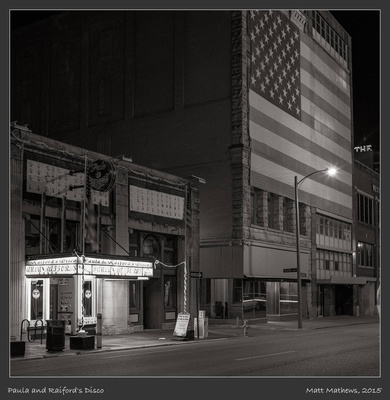 Paula and Raiford's Disco, 2015
Paula and Raiford's Disco, 2015
But it was not the city alone that changed at night. So did its inhabitants. Brassaï turned his camera on lovers embracing in the privacy of dark parks, prostitutes courting the attention of potential johns, and the invisible workers of the night -- butchers, delivery persons, rag collectors, police officers, street repair crews, and others whose work often prepared the city for life by day.
From the moment I first opened my anthology of Brassaï's photographs, I was intrigued. I had never really explored any city at night with creative or visual depth. And so, after living with Brassaï's work for several years, I decided to wander Memphis at night, and I decided to do so with an old medium format film camera from the early 1960s as fully manual and nearly as clumsy as Brassai's Voigtländer Bergheil camera.
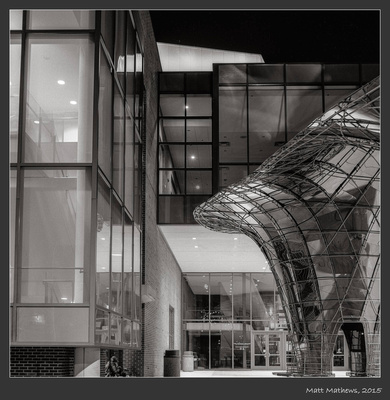 Homeless Man and Architecture, Cannon Center, 2015
Much like Brassaï, when I go out at night, I go as a flâneur -- a walking drifter, an aimless wanderer persistently available to whatever Memphis by night wants to reveal. I have ideas, hunches, and instincts that I follow, of course, but nothing is a sure bet, and there are always surprises and much improvisation. I wander dark alleys where I hear squeaking rodents and see chefs out smoking on their breaks. Other times I meet homeless people huddled in obscure corners or young professionals moving between bars, restaurants, and sporting events. Then there's the occasional security guard, underpaid and hungry for validation, who meets me with suspicion or excessive chattiness.
Homeless Man and Architecture, Cannon Center, 2015
Much like Brassaï, when I go out at night, I go as a flâneur -- a walking drifter, an aimless wanderer persistently available to whatever Memphis by night wants to reveal. I have ideas, hunches, and instincts that I follow, of course, but nothing is a sure bet, and there are always surprises and much improvisation. I wander dark alleys where I hear squeaking rodents and see chefs out smoking on their breaks. Other times I meet homeless people huddled in obscure corners or young professionals moving between bars, restaurants, and sporting events. Then there's the occasional security guard, underpaid and hungry for validation, who meets me with suspicion or excessive chattiness.
Sometimes people express interest and talk to me, but mostly they ignore me. Some look quizzically in the direction where my camera is pointed, puzzled and wondering what on earth could possibly be worthy of a picture. They are puzzled because they are still seeing and living as day people in the night world.
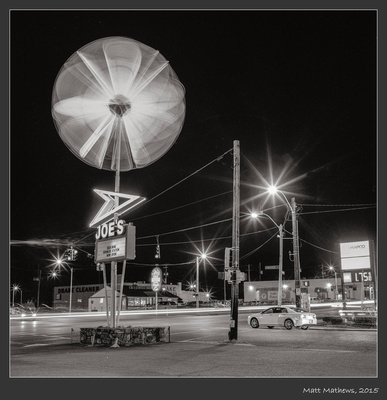 Sputnik at Joe's Liquor, 2015
With "Memphis by Night," my aim is not merely to imitate Brassaï. I have focused far less on the people and far more on the cityscape of the night. I am especially intrigued by the way the long exposures required by night film photography capture the blurred movement of people, cars, water, spinning signs, and public art. Such movement did not seem to interest Brassaï. And in an age in which the camera has become a suspicious instrument of universal surveillance, I cannot take the camera into bars, restaurants, or hotels to photograph people as Brassaï did eighty-five years ago. Night-lit architecture calls me instead.
Sputnik at Joe's Liquor, 2015
With "Memphis by Night," my aim is not merely to imitate Brassaï. I have focused far less on the people and far more on the cityscape of the night. I am especially intrigued by the way the long exposures required by night film photography capture the blurred movement of people, cars, water, spinning signs, and public art. Such movement did not seem to interest Brassaï. And in an age in which the camera has become a suspicious instrument of universal surveillance, I cannot take the camera into bars, restaurants, or hotels to photograph people as Brassaï did eighty-five years ago. Night-lit architecture calls me instead.
In the end, though, I have come to share Brassaï's insight, tinged as it is by surrealism, that "[n]ight does not show things, it suggests them. It disturbs and surprises us with its strangeness. It liberates forces within us which are dominated by reason during the daytime."*
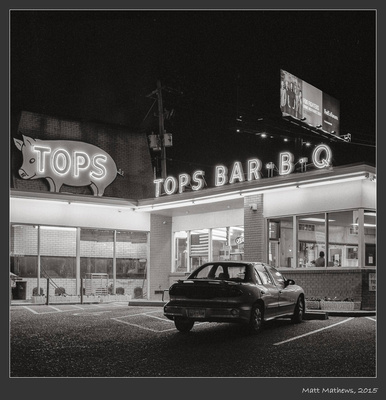 Tops Bar-B-Q, 2015
Tops Bar-B-Q, 2015
 Mississippi River and Hernando DeSoto Bridge, 2015
Mississippi River and Hernando DeSoto Bridge, 2015
----------------------
*quoted in Jean-Claude Gautrand, ed., Brassai: Paris (Koln: Taschen, 2008); p. 32
]]>
My book of 36 photographs of the the stained-glass windows of Simpson United Methodist Church, Evansville, Ind. is available for purchase online. See details below. You may also download a free E-book version below.
There are three purchasing options:
Option 1: An 8” x 10” Soft Cover Book available for $24.49 plus shipping. Click Here
Option 2: An 8” x 10” Hard Cover Book available for $36.49 plus shipping. Click Here
Option 3: A 13” x 11” Hard Cover Book available for $60.19 plus shipping. Click Here
Free E-Book:
To download the free E-Book version, which is great for tablets such as iPad or Kindle, click below. Since tablets vary, I cannot supply viewing instructions. Your tablet will need a PDF-reader program, and most have one already installed.
If you are using an iPad, click on the link below, download the file by touching the download icon (downward facing arrow at bottom right of screen). Once the E-book opens in your browser, touch in the upper right of the viewing area and you can transfer the E-book to the iBooks app and it will be viewable as a book in your library.
Click Here to Download Free PDF E-Book
The content of the book is the same across all print versions and E-Book versions.
]]>
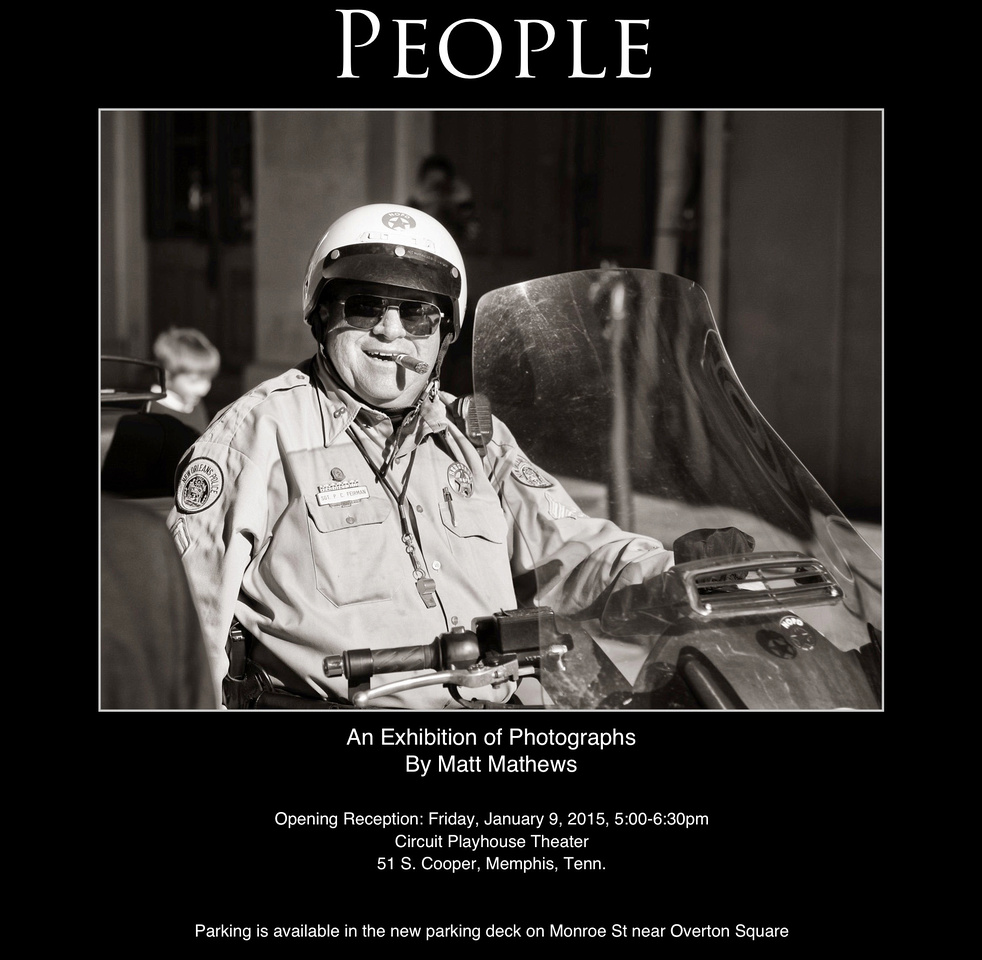
"We're born naked, and the rest is drag."
-- RuPaul, Drag Queen

In Lawrence and Meg Kasden's 1991 film "Grand Canyon," there is a scene in which Mack, a wealthy lawyer, and Simon, a working class tow truck driver are discussing the Grand Canyon. Part of their exchange follows.
Simon: [sighs] When you sit on the edge of that thing, you just realize what a joke we people are. What big heads we got thinking that what we do is gonna matter all that much. Thinking our time here means diddly to those rocks. It's a split second we been here, the whole lot of us. And one of us? That's a piece of time too small to give a name.
Mack: You trying to cheer me up?
Simon: Yeah, those rocks are laughing at me, I could tell. Me and my worries, it's real humorous to that Grand Canyon. Hey, you know what I felt like? I felt like a gnat that lands on the ass of a cow that's chewing its cud next to the road that you ride by on at 70 miles an hour.
Mack: [laughs] Small.
We human beings often suffer from delusions of grandeur, assuming that we are the measure of all things. We labor under the illusion that our petty conflicts and triumphs are the metric of meaning in the universe. We imagine a world that exists solely for us, and we even refashion God into a cosmic sugar daddy who dotes over us, waiting to shower us with prosperity. But this small world with its even smaller god is an illusion.
It is very difficult to maintain this illusion when you sit on the edge of the Grand Canyon or hike in the deserts of the Southwest. In such places, we feel acutely our smallness and sense the landscape's inhospitality to human life. There is rarely water to drink. The sun scorches the skin. The wind drives fine dust into eyes and camera lenses. There is little shade. And then there are the rattlesnakes, scorpions, and tarantulas. Such places were not made for us. We are aliens in a foreign land. The God of this place is far more interested than we are in things other than us.
And yet, such wildness is terrifyingly beautiful. Such beauty transforms rather than entertains us. It tears loose our desperate, controlling grasp on ourselves and the world. It topples our little god. Such beauty dislocates us. Then it relocates us in a new world governed by a vast and different economy of meaning. It frees us to be gnats on a cow's ass as the cosmos goes speeding by at seventy miles per hour.
This belittling power of beauty is not the same as the petty belittling we do to one another as human beings. It does not erase our or another's humanity. To be small in a big world means that there's room for all. Beauty frees us to be fully, authentically human together.
Poet Muriel Rukeyser reminds us that "the universe is made of stories, not of atoms."* Beauty narrates a new story, a grand new epic with a new plot, new values, and new characters. Where we once worked anxiously to fit episodes of beauty into the big story of our lives, we now find that our lives are but small episodes in the grand epic of beauty that envelops them and all that is.
We are saved by smallness.
-------------------------------------
*Muriel Rukeyser, "The Speed of Darkness" (1968)
]]>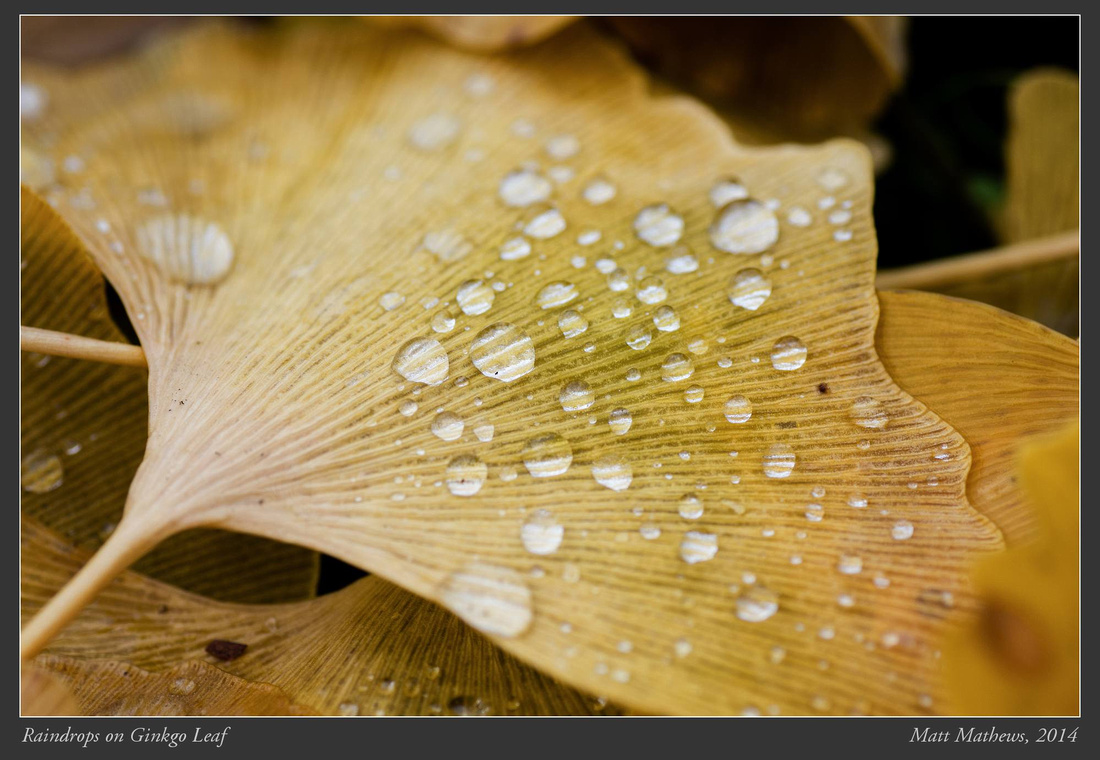
Photography is my discipline for learning to be fully present to the world. When I take up the camera, I go exploring, tuning my senses to things that I might otherwise pass by in busyness and habit. It is an act of devotion to the real that frees me from constricted awareness and bondage to the illusions that so easily creep into daily life. It has taken quite awhile for me to arrive here, and along the way I have succumbed to a few temptations.
When I began photographing, I fell for the temptation of believing that there was a perfect camera, lens, or tripod which, if I found and bought it, would catapult my pedestrian photographs to greatness. And surely, there is a benefit to finding the right gear that suits your photographic style. To make good photographs, you need the right tools the same way a master woodworker needs the right tools to make great furniture. But camera gear does not make good photographs. Attentive photographers do.
I next fell for the temptation of believing that I could only make good photographs in exotic, picturesque places. I've walked along many miles of desert, forest, and beach, and I've made some good photographs along the way. To make good photographs, you regularly need the stimulation of new environments that evoke wonder, delight, and experimentation. But picturesque places do not make good photographs. Attentive photographers do.
And finally, I succumbed to the temptation of believing that strict adherence to rules of graphic design and composition would transform my photographs into great ones. So, I learned the rule of thirds, mastered the color wheel, faithfully sought out leading lines, and attuned myself to the siren song of the s-curve. And I learned that such design and compositional techniques do, in fact, enhance the visual poetics of my photographs. But such techniques do not make good photographs. Attentive photographers do.
Tools, travel, technique -- these are things that belong to what the ancient collection of Taoist writings known as the Chuang-tzu calls Little Understanding. Little Understanding is largely technical in nature and it is indispensable to creativity. But there's another kind of knowledge, the kind the Chuang-tzu calls Great Understanding. Great Understanding is creative vision born out of unconstricted attentiveness to one's environment. It is intuitive, unforced, spontaneous, and responsive to surprise. It is attuned to the mystery in the ordinary. Great Understanding involves heightened awareness of the evanescent and fleeting character of each moment of existence, and it lingers there, seeking not to own, possess, or control things. It lingers there to participate in and enjoy communion with things, but then lets them pass away as they inevitably must.*
I was reminded of the importance of Great Understanding again this week when I walked out to my car on the driveway. In the ten-second walk from my front door to the car, I was struck by the sullen, grey morning skies and the piles of leaves that the wind had blown into my front yard. I noticed the raindrops from early morning still on some of these leaves, and I was especially intrigued, for reasons I cannot fully explain, by the ginkgo leaves. And so, I reached for my camera and lost myself for an hour in the Great Understanding of the leaves.
Raindrops on a Ginkgo Leaf is one morning's triumph over old temptations and a savoring of Great Understanding.
-------------------
*I am indebted to Philippe L. Gross and S.I. Shapiro's The Tao of Photography: Seeing Beyond Seeing (Berkeley: Ten Speed Press, 2001; pp. 10-12) for this discussion of Little and Great Understanding.
]]>
Last Saturday, I was combing the backroads of northwest Mississippi, looking for worthy photographs. This is the land of the Mississippi River Delta, and it is flat, low, fertile earth nourished over the years by the floodwaters of the Big Muddy. It is the land of King Cotton. It was once the land of slavery and unspeakable suffering. It is the land over which southern and northern troops moved during the Civil War. It is a land that bears the marks of its history in the still wide gap between black and white.
As I approached an intersection of two country roads, I spotted a roadside memorial to Yolanda, who died tragically in an automobile accident. Like most of us, I have seen many such roadside memorials, especially in the American Southwest where they are known as descansos, "resting places," and can be traced back to the centuries-old, Hispanic-American practice of marking the landscape with memorials wherever weary pallbearers briefly set down the casket on their long walking journey to the burial site.
I know virtually nothing about Yolanda, except that she died too young and died tragically on this little patch of flat and fertile land that has already known too much suffering in American history. I was moved by the austerity and simplicity of this handmade marker. The little angel figurine at the base of the cross has begun to dissolve and crumble in the elements. And with time, storms, and winds, the paint will fade and the wooden cross will fall over and disappear into the soil.
RIP Yolanda is someone's protest against private grief. It is a stubborn refusal to confine grief to the church, cemetery, or home. In a North American culture that denies death and often covers over its tragedy with embalming fluid, makeup, and tidy, otherworldly religion, RIP Yolanda takes us to the public place of senseless tragedy, the place where a particular young life was lost in a patch of dark Delta dirt. Set against the flat, wide, almost horizonless expanse is this place of particularized loss and grief, so poignant and intimate it goes only by a first name. Here is a public commingling of memory, sorrow, and warning to others traveling these isolated roads. If there is genuine redemption in this place, we struggle to find it.
What troubles us about RIP Yolanda is the lack of information surrounding it. We want to fill in the gaps, weaving together a possible biography and coherent account from a million loose threads of obscure clues and gross generalizations snatched up in a quick drive through of the nearby town. We speculate about the cause of the accident that killed her. We wonder if she or another party was to blame. We imagine speeding, drunk, sleepy, or preoccupied drivers. We want to sort out the sheep and the goats, the virtuous from the villains. We long for a morality tale that will provide an ersatz redemption for the whole damned thing. But none is given.
In the end, RIP Yolanda sets a question mark against all the easy exclamation points that punctuate our morality tales. And paradoxically, that may well be what redeems the tragedy, freeing Yolanda and us from easy answers, religious bromides, and morality tales too good to be true. Perhaps then, and only then, can we say with the ancient Hebrew writer, "Though God slay me, yet I live."

In April 1927, Ansel Adams spent a day hiking up toward Half Dome in Yosemite. The trip was long and hard, and by the time he arrived at his final destination, he had only two unexposed glass plates left. Once at the Diving Board, a small rock protrusion below the face of Half Dome, he was overwhelmed by the beauty and immensity of the sheer granite wall towering over him. As he set up his view camera and readied it for the exposure, he realized that the photograph he was about to make would not communicate the experience of that moment. The photograph might faithfully duplicate the shapes, textures, and landscape, but it would not capture the experience of being overwhelmed by this massive monolith that in some ancient past had lost half its face in an apocalyptic crash of rock.
Adams later said that what he wanted was to "make it look how it felt." A straight exposure could not do that. So, Adams reached for his heavy red Wratten A filter, which dramatically darkened the surrounding sky and much of the face of the granite. This creative choice imparted drama and awakens in viewers a sense of the monolith's foreboding presence. The resulting photograph, Monolith, the Face of Half Dome, has a gothic and ominous quality that unsettles us even as it lures us. It retains this power despite the damage to the negative from the 1937 fire in Adam's darkroom that requires the prints to be cropped tightly at the top.
In early 2009, I was photographing in Yosemite during an early spring storm. I approached Half Dome and stood alone in the meadow beneath it, watching as the clouds drifted across it, sometimes revealing and other times concealing its surfaces and details. As I watched, gusts of wind lifted flurries of snow off its face and swirled them beautifully around the granite. Watching this primordial dance of granite, ice, clouds, and wind, I felt the mountain.
When we feel the mountain, we feel our own smallness. We are reminded that we are neither the measure nor the measurer of all things. We realize that we are measured by forces beyond ourselves, forces that both bear us up and bear down upon us. Such experiences deliver us from our exaggerated sense of our indispensability to the cosmos.
This sobering sense of our smallness opens the possibility of living more joyfully. It permits us to be creatures again unburdened by graceless perfectionism. It beckons us to embrace our fragility and limitations, and to love and be loved through them. It calls forth compassion for ourselves and all other creatures in the face of our and their partialities.
Storm over Half Dome asks you to feel the mountain.

]]>
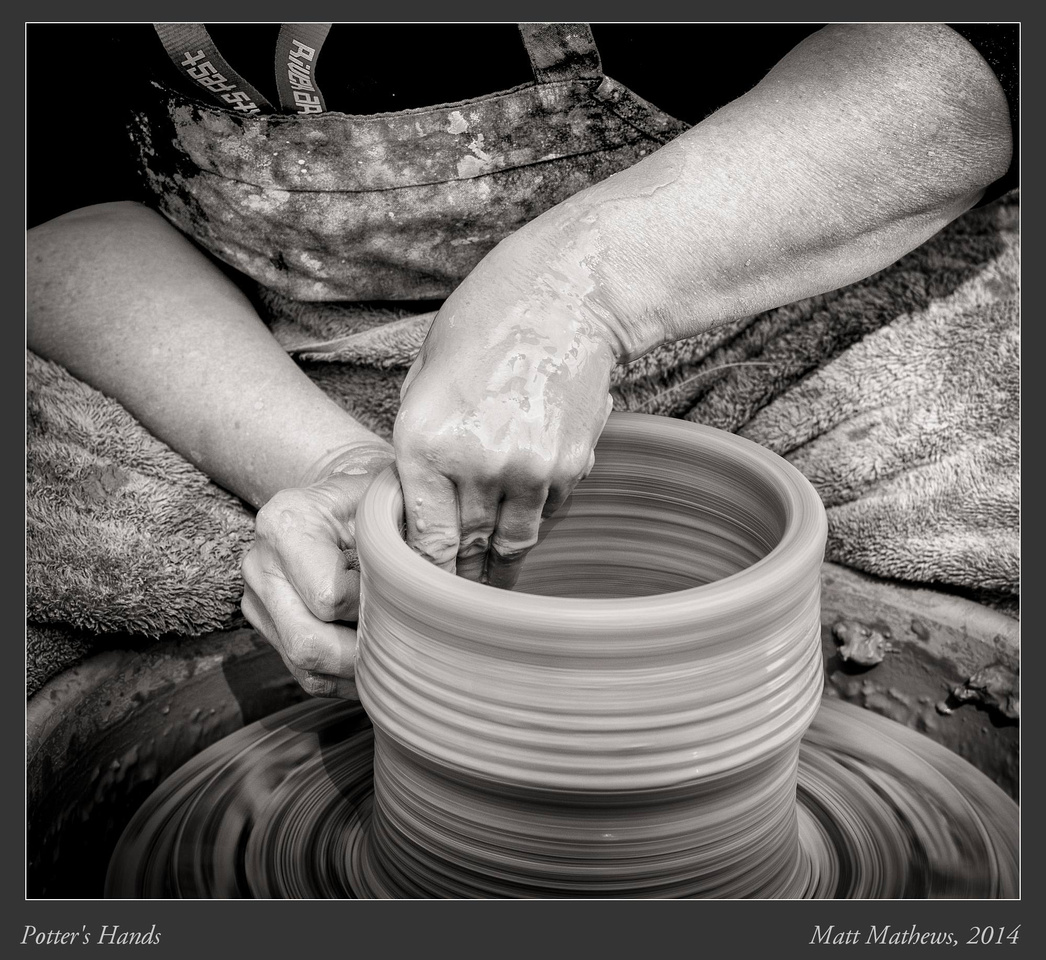
When as a child I watched my great grandmother knit, I was mesmerized by how quickly and instinctively her hands moved to make the delicate stitches of her sweaters. She did not think about or even look at each stitch. The stitches just flowed effortlessly from her hands as she talked to me. I remember those hands whenever I watch commercial fishermen filet their fish with the same kind of effortless, unthinking movements of hand and knife. And I remembered them again today when I watched the hands of the potter as she deftly and effortlessly turned a shapeless lump of clay into a bowl right before my very eyes.
Grandma's hands and those of the potter point to kinesthetic knowledge. Such knowledge is not of ideas or concepts. It's not of anything. It's instinctive know-how accumulated through hours of practice. It is an intuitive capacity for rhythmic movements and practiced gestures, all well-timed and economically executed in pursuit of a craft. Such knowledge is seated in the memory of muscles. We only acquire it through the movements themselves. Movements that begin as clumsy, slow, and awkward become skilled, quick, and graceful the more we do them. When the fingers meet the mud and clay, they just go to work, reflexively increasing and decreasing the pressure first here and then there, adjusting effortlessly to the texture and thickness of the clay as the wheel turns. Such knowledge is not linear, conceptual, or verbal; it's intuitive, reflexive, and somatic. It's fluidic improvisation. The Taoist speaks of it as wu wei, "effortless effort."
Potter's Hands reminds us that such kinesthetic knowledge is beautiful to witness. When mud-slathered fingers conjure form from a formless lump of clay, we are reminded of our own connectedness to earth and mud. We are brought back to elemental things, to the ancient, primordial awareness that we are enfleshed spirits most at home in earthy mud. Potter's Hands calls us back to our flesh and beckons our spirits to embrace it and conjure up some fresh beauty of our own.
]]>
We used to "behold" things. We don't anymore. Somewhere along the way, Behold fell out of our vocabulary and doing it from our practice. Etymologically, it derives from the Old English word bihaldan, which meant to "to give regard to," "to hold fast," or even "to belong to." Behold is an unfashionable word, but more to the point, it is an unfashionable practice in a culture dominated by the busy person's glance, the consumer's looking for, and the Pharisee's stare.
Beholding something requires that we offer it our total attention, that we allow ourselves to be captivated by it in wonder and awe. When we behold something, we encounter it as gift and mystery. When we behold things, they do not so much belong to us as we to them. Beholding things means lingering over them with a long, loving gaze, running our finger over the sharp edges of their beauty, and swaying to their silent melodies. When we behold, we participate in and even enjoy communion with what stands before us. And when we are done beholding, we release the butterfly that it might fly away.
We are often too busy to behold. The best we can muster is a glance. We pass our eyes over things casually and quickly. We give no regard, grant no honor, perceive no intrinsic value in the things at which we glance. We see casually, lacking mindfulness. In the hustle of modern life, we merely scan over things so we don't bump into them. The glance often grows in the soil of our exhaustion, habit, and apathy.
When we manage to move beyond the glance, it is often to the commodifying gaze of consumerism. This is the gaze of the shopper that looks twice, first at the thing, then at the price tag. This is seeing as looking for -- looking for a bargain, a sale, or a curio for the living room shelf. It is the kind of seeing that quantifies, calculates, compares, manages, commodifies, and, in the end, owns. Such seeing is not really a seeing of the world but a seeing of mere products.
More dangerous still is the Pharisee's stare which meets what stands before it with a condemnatory gaze that is at once disdainful toward but thrilled by the forbidden. When we stare, we reduce what stands before us to a freak that attracts us even as it is forbidden to us. When we stare, we see pornographically. We do not participate in communion with the deep goodness of what stands before us. Instead, we watch from the side, emotionally disconnected even as our bodies, in this case our eyes, are aroused. The freak entertains us but does not call forth from us empathy, only disdain tinged with titillation. Fear triumphs over love, objectification over communion, pity over solidarity, judgment over grace, voyeurism over participation.
Beholding is graced seeing. It is an act of love that not only releases what is seen from our grasp but enables us to release our grasp upon ourselves. Beholding changes us for the better. Glancing, looking for bargains, and staring do not. When we behold things we see their glory and splendor, and this gradually remakes us.
Behold, Magnolia Blossom, No. 1.
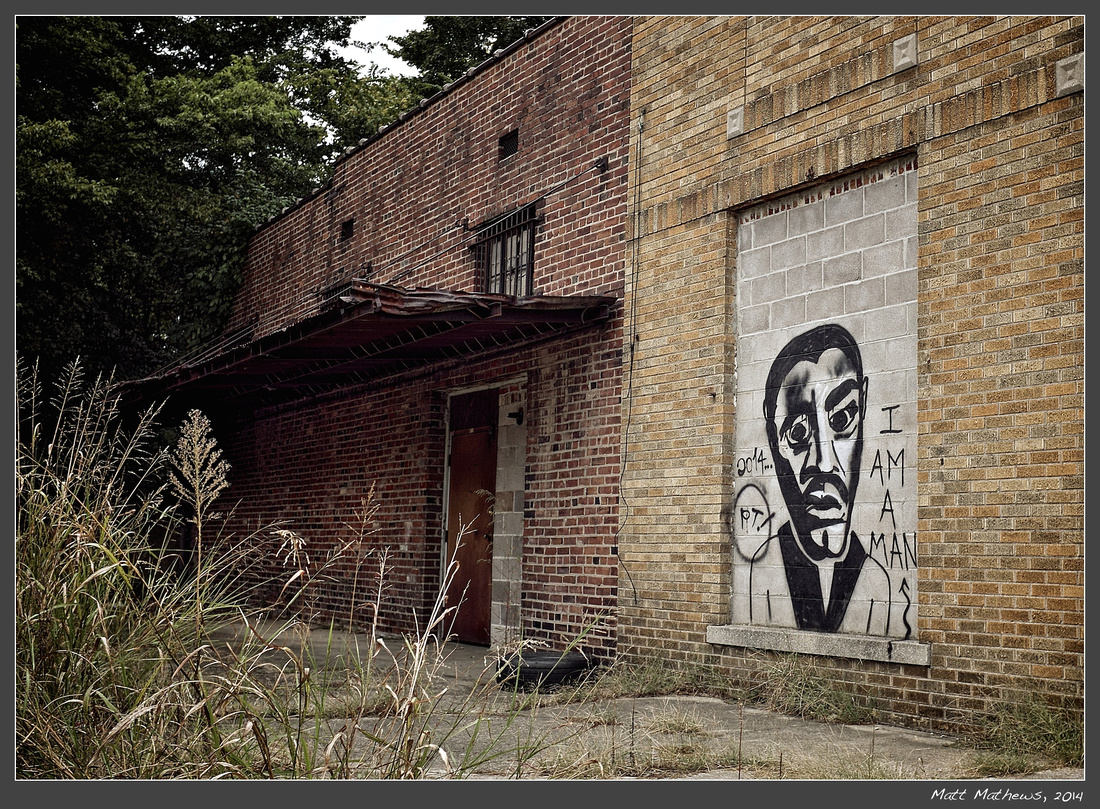
Ode to Ernest Withers, 2014
I knew Ernest Withers's photographs long before I ever knew it was he who had made them. Withers (1922-2007) was a photographer based in Memphis, Tennessee who photographed celebrities. But most importantly, he was one of the premiere photographer of the Civil Rights Movement. Withers's images are for the Civil Rights Movement what Matthew Brady's images are for the Civil War, what Ansel Adams's are for Yosemite, or Dorothea Lange's are for the Great Depression. Withers enjoyed unparalleled access to Martin Luther King, Jr. and other civil rights leaders, and he knew well the power of photography to strike at the American conscience and exert moral suasion. If King was the preacher, the wordsmith who moved a nation, then Withers was the seer whose photographs cast in silver tones the concrete, deeply intimate nature of the struggle as felt by African Americans.
Withers's photographic corpus of the Civil Rights Movement is very large, and in photograph and photograph we see a master of composition, timing, and exposure. In an age in which cameras often lacked light meters and lenses had to be focused manually, Withers always managed to get the iconic photograph. His technical abilities, though, were in service of a deeper vision. While his vision included photographing the large scale events of the movement, his brilliance, in my judgment, lay in his capacity to depict the struggle as it played out on a very intimate, human scale. Many of his images concentrated the struggle in a single individual or small group of people, often keenly focused on body language and facial expression amidst the palpable absurdities of daily life in a segregated society. We see these motifs in his Martin Luther King Resting on a Bed and in No White People Allowed in Memphis Zoo Today; or in one of my favorites, Father with Daughter in Stroller (1961).*
But Withers's most famous photograph is I Am a Man (1968). This photograph depicts the sanitation workers gathered outside Clayborn Temple on the corner of Hernando Street and Linden Avenue (now Martin Luther King, Jr. Boulevard) in downtown Memphis preparing to march. Few photographs express with such poignancy the personal as well as political nature of the movement. This was no mere political movements for rights, power, and equality; it was a spiritual movement demanding full personhood, and yes, even full manhood in the over-"boyed," segregated South.
This past Sunday, I went down to Clayborn Temple, now a boarded-up, for-sale shell of a building. It was often here that King delivered his speeches, huddled with his inner circle of leaders to plan strategy, and it was on this corner where the marchers gathered to begin their protests. It is sad to see this old African Methodist Episcopal Church building in such a state of decay. I went looking for a photograph but came away with none. It was a disappointing photographic outing.
As I left Clayborn Temple, I drove east on Vance Avenue, and several blocks up from the church I saw the scene depicted in my Ode to Ernest Withers, 2014. It took a moment to realize what I was seeing. When I did, I drove around the block for a second look. This time, I stopped and made the photograph, sensing acutely the connection between this bit of graffiti on the wall of a unimpressive vacant building and Withers's I Am a Man, made forty-six years earlier just a few blocks away. My photograph samples the lyrics of I Am a Man, but it does so at secondhand. I am after all merely sampling the lyrics of the graffiti artist who first sampled Withers's lyrical I Am a Man.
This sampling, of course, bears witness to the ongoing power of Withers's initial image. In I Am a Man, we feel the Civil Rights Movement. We see that while it was about rights, power, and equality, it was also about asserting, celebrating, and embracing one's own somebodyness in a world that daily tried (and tries) to erase you into nobodyness. It is here that we can see that before the Civil Rights Movement was a political movement, it was a spiritual movement born out of the Black Church and borne along by it.
When secular historians are tempted to overlook this fact, analyzing the movement only as a series of well-played political stratagems, we have the witness of Ernest Withers and a graffiti artist to lead the protest. Before Withers or the sanitation workers were "political players," they were "men."
*These titles of the photographs were not assigned by Withers; I have simply created them for purposes of this post.
]]>
The great mystically minded photographer Minor White claimed that "one should not only photograph things for what they are but for what else they are."
Photographs invite us to see the ordinary things of everyday life in a fresh way. They can be arresting, stopping us in our tracks. They disrupt our routine, casual ways of seeing and being present to the world. Something as simple and common as a strand of seaweed floating aimlessly in dark water beneath a dock suddenly appears as something quite beautiful. And for a brief spell at least, it's hard to go back to seeing seaweed the same old way we always do. Part of the power of photography as a medium is its faithful, unforgiving, relentless depiction of the things as they are. There is a clinical exactness to the medium not commonly found in other art forms. This clinical exactness draws us more deeply into the thing, inviting us to see details in it that we might otherwise overlook. A photograph connects us to a thing in its unrepeatable particularity. Kelp, No. 2 is not about seaweed in general; it is about this strand of seaweed floating in this water at this moment bathed in this quality of light.
And yet, Kelp, No. 2 is about more than this particular strand of kelp. It is a study of lines and curves, of subtle gradations of tone that create depth and dimension, and of textures set against a glassy smooth background. Here, I think, is the "something more" to which White was referring. These lines, curves, tones, and textures bear witness to the deep structures of being itself. They touch the metaphysical beneath but always manifested in the physical. Ours is a world expressive of order, of an underlying purposiveness. Ours is a world of rhythms, harmonies, and creative dissonances. When we experience these dimensions of a beautiful thing, we are experiencing something objectively real about the world. When we experience this it evokes something powerful in us. It evokes a sense of rightness and well-being. We sense that the world in which we live is not a cosmic accident governed by fortune and chaos. We sense that this world is right, that it is as it should be, and that there is a place within it for us to flourish. And while ours certainly is not the central place, it is nonetheless a good place where the forces that bear us up in grace, hope, and love are ultimately greater than those that bear down upon us in tragedy, evil, and suffering.
When experiences of beauty attune us to a sense of cosmic rightness and well-being, they ultimately anchor us as moral selves. Before we can sense injustice, be angered by unfairness, or commit ourselves to a moral cause, we must first sense dissonance -- the dissonance between how things are and how the cosmos intends them to be. Experiences of beauty thus assure us, often more affectively than cognitively, that "the moral arc of the universe is long but bends toward justice" (Martin Luther King, Jr.). It is only out of this felt experience that moral motivation and commitment emerge or are sustained over time. When our pursuit of the good is disconnected from our pursuit of the beautiful, the moral life becomes the merely moralistic life that soon withers and dies from lack of spiritual nourishment. We need to sense that our moral strivings are not simply our moral strivings but participate in a deeper ontological force that exerts a persistent momentum toward cosmic rightness and the well-being of all creatures.
In the end, seeing a little seaweed from time to time may well rescue us from self-righteous, self-serving do-goodism.
]]>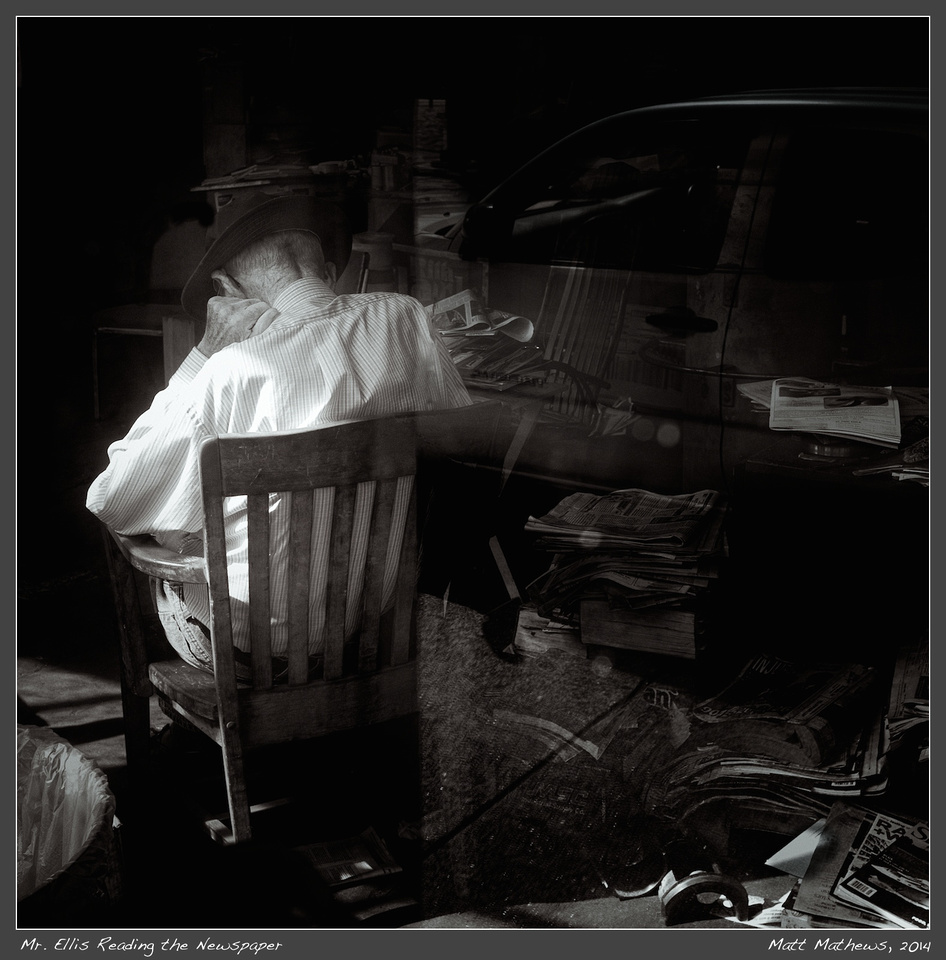 Mr. Ellis Reading the Newspaper
Mr. Ellis Reading the Newspaper
In the years that I have been photographing seriously, I have rarely had a second chance to correct a serious creative error. This week, I got such a chance.
In 2009, I had the honor of photographing inside The Ellis and Sons Iron Works located on the corner of Front Street and Martin Luther King, Jr. Boulevard in Memphis, Tennessee. Ellis and Sons is among the oldest, continuously operated businesses in Memphis, and despite profound economic shifts that have severely diminished the business, it survives. In 2009, I enjoyed spending a few hours inside the foundry, photographing the massive machinery and interesting textures, lines, and shapes that fill this old warehouse. I remember that around every turn in this old building were so many interesting things to photography that it felt overwhelming. Among the favorite photographs that I made that day in 2009 is this one of a piece of machinery used to melt metals for casting into molds.
My mistake in 2009 was failing to photograph Mr. William Ellis himself, the namesake and direct descendent of the founder of the business. I met Mr. Ellis that day, already then in or fast approaching his nineties, and he was among the most gracious and proud men that I have met. He has worked in this same factory since he was a fourteen-year-old boy. He toured me around the shop, telling me of the history of this family-owned business that an earlier Mr. William Ellis established in 1862 to cater to the boats carrying freight on the Mississippi River, one block west of the foundry. Mr. Ellis then gave me free rein to wander through his shop unattended. And yet, I never turned my camera to Mr. Ellis himself. I have regretted this oversight every time I review the collection of photographs of the industrial forms I made that day.
Today, I atoned for my creative sin. While walking in the South Main District of Memphis during the late morning hours, I wandered past the Ellis and Sons Iron Works building. As I did, my mind went back to 2009 and my failure to photograph Mr. Ellis. And suddenly, there he was, visible through a dirty old window of the foundry, surrounded by piles of newspaper and equipment and framed by reflections cast in the window. There he sat in soft midmorning light reading the newspaper as he probably does every day. And he did not see me.
First I photographed him from the front to reveal his face; and then it struck me that a far subtler photograph was to be had if I photographed over his shoulder, and just as I moved into position, he lifted his left arm and rested his hand on his neck. When I made the exposure, I knew immediately that I had the photograph that I have longed for for five years.
After I made the photograph, I considered going inside to ask if I might photograph him formally. For a moment, I worried about the clutter surrounding him in the portrait and thought a photograph made inside would be "cleaner." But then I realized that this clutter has surrounded him for the eighty years that he's worked in this building, and it is part of what defines him. So, I did not go inside. I knew that I had the photograph that I wanted. But more importantly, it seemed that going in and interrupting him would diminish the extraordinary manifested in this most ordinary of moments.
Photographers rarely get second chances, but on this day I did. And I am deeply grateful for having been in the right place at the right time.
Cheers, Mr. Ellis. Carry on with your daily routine. And thank you for a moment in which the ordinary was suddenly bathed in the extraordinary.
]]>
Jewelry Craftsman, Clarksdale, Mississippi, 2013
I have come to believe that the art form most similar to photography is poetry. The poet aims for an economy of words, subtracting all extraneous ones in the pursuit of highly concentrated meaning. Photographers do the same. We seek to concentrate meaning by the subtraction of all elements in a scene that might dilute it. And like the poet, we must embrace inherited forms for our creativity. Just as with the poet who chooses to write a haiku or sonnet, the photographer chooses to work within inherited structures, aesthetic forms, and visual traditions that place constraints on the creative act. Such constraints, however, far from stifling creativity, call it forth. And finally, like poets, photographers use rhyme schemes. Photographs hold our attention quite often because their visual elements curiously echo one another, creating a pleasing visual rhyme. In Jewelry Craftsman, for example, we might notice that the craftsman holds in his right hand a clip that faintly echos the end of his prosthesis. Or again, as we look a bit longer, we might notice the rhyme between the missing letter of "Handcrafted" and the craftsman's missing hand.
But most importantly, poems and photographs traffic in metaphors. Etymologically, metaphor is interesting. Metaphorein in Greek literally means "to carry over" or to "carry beyond," and here is a curious thing. Metaphors carry us over a gap between two worlds of meaning. And yet, in carrying us over, there remains an elusive beyondness to the new land of meaning that prevents us from fully occupying and domesticating it. Metaphors bring into view a great beyond, and they tease us by letting us visit and even touch it briefly but never own, possess, or fully control it. Metaphors, to borrow a phrase from the Hungarian photographer Brassai, "suggest rather than insist."
The late French philosopher Paul Ricoeur famously spoke of metaphors as having "a surplus of meaning," by which he meant that metaphors can never be fully translated into straightforward pedestrian prose without losing something in translation. When explanatory prose reaches out to grasp the meaning that metaphor throws out in front of us, its reach is never quite long enough. The metaphor eludes conceptual mastery, insisting on an element of indeterminacy and openness beyond exhaustive translation. This playful surplus of meaning is what holds our imagination even as it confounds the reductive impulses of the the mind. We get tangled up in metaphors, and in their bondage we find freedom and delight. In the swirling world of the metaphor, we touch levels of cognitive and affective meaning in ourselves and in the world that have hitherto eluded us.
Jewelry Craftsman is a visual metaphor. When I look at it, I am confronted by the fragility of human existence, by the power of beauty to embrace loss, tragedy, and brokenness in an act of redemptive transfiguration. I am confronted with the constant interplay of the organic and mechanical in modern life. I am reminded that much of life has an improvisational character where we must learn to make our jewelry with what's left over. Jewelry Craftsman throws out in front of us the tangle of our own loss and triumph, our own stubborn knots of brokenness, creativity, and new possibilility.
But look again at Jewelry Craftsman. It is at once less and more than all this. My hope is that it's worth more than a thousand words.
]]>Pride festivals and parades are about many things: celebration and defiance, excess and performance, sexuality and spirituality, costumes and authenticity, liberation and justice.
When one photographs at a Pride event, one can approach the task as either a voyeur or participant. I choose to be the latter. I seek to enter fully into the festival, and more importantly into the broader struggle of LGBTQ people. Participation is an act of solidarity rather than charity. Charity is merely the momentary, guilty conscience of the voyeur.
The way of solidarity involves forming deep, abiding friendships with LGBTQ people and other allies, nourishing and being nourished by a shared life that both transcends and includes the multitude of ways we are different from one another. It means coming alongside a marginalized but triumphant people, not as a self-appointed straight liberal savior, but as an empathetic friend who shares the burdens, the struggles, the victories, the defeats, the joys and laughter, the anger and pain. Solidarity means sticking around and finding your own life only when you lose it in the lives of others.
One of the gifts of solidarity is authenticity, and in the case of solidarity with my LGBTQ friends, it is an authenticity that regularly calls me forth from my own closets filled with false identities that are safe and comfortable. While the closets of LGBTQ people are often especially dark ones filled with toxic air that suffocates the spirit, most of us have closets of our own where we retreat and trade authenticity and flourishing for various false selves hell-bent on mere survival and unreflective social conformity.
When I photograph Pride events, it is a gesture of thanks and admiration to the LGBTQ community and its allies for empowering me to transgress with queer courage and drag-queen delight all those carefully guarded, arbitrary boundaries that masquerade falsely as natural and essential to my and society's wellbeing. My LGBTQ friends make me a better photographer and theologian, and in the end a better human being.
And it is to these friends that I say "thank you" with these 43 photographs. If you would prefer to see the photographs in the gallery or if your internet connection does not permit uninterrupted viewing of the slideshow below, click here.
]]>
Artist Statement
“We should not merely run [our eyes] over [creatures] cursorily, and, so to speak, with a fleeting glance; but we should ponder them at length, turn them over in our minds seriously and faithfully, and recollect them repeatedly."
-John Calvin, Institutes 1.14.21
“Beauty, catch me on your tongue.”
-Andrea Gibson, “Birthday”
Faith is deliciously sensuous. It calls forth from us a long, loving look at the extravagant beauty of the world. Faith brings mindful seeing, a renewed attentiveness to the handiwork of God all around us. In faith, we are invited to attend to things small and large, fragile and threatening, with patience, delight, and awe. We are summoned to linger over particulars with heightened sensitivity and an expectation of surprise. Faith transfigures our casual seeing into the wonder-filled, wide-eyed gaze of a child. For Calvin, such seeing is an expression of gratitude, and when we fail at it, he judges us of guilty of "criminal apathy."
"Beauty, Whole and Broken" is a collection of photographs that invites us to acquit ourselves of the crime. These photographs celebrate two kinds of beauty. The first is whole beauty -- the beauty of pristine things free of defect and flaw. Such beauty is of things untouched by fallen human hands and free of tragedy, flaw, or brokenness. We see such beauty in the luminous blossoms of the dogwood, in a strand of seaweed floating aimlessly in dark waters, and in a moonrise over granite dells so strange in shape that we might mistake them for an alien world. To taste whole beauty is to taste the original goodness of God and the world and to be reminded that even though ours is but a small place in the world, it is a good place.
But even whole beauty gets broken. Wildfires ravage pristine landscapes. Here is another kind of beauty -- broken beauty. This is an improvised beauty that embraces tragic or flawed elements and transfigures them into something higher. We glimpse such beauty in the one-armed craftsman of hand-made jewelry whose hand holds a clip that echos his prosthesis. We see this beauty in the bliss of a boy riding a mechanical bull whose missing horn imperils the illusion. We see it in the bluesmen whose notes and voices squeeze beauty out of the depths of human suffering and anguish. To taste broken beauty is to taste redemption and to be reminded that God's beauty travels through the tragic rather than around it.
O Divine Beauty, "catch [us] on your tongue."
]]>
Viewers of my photographs sometimes ask why I work in black & white more often than color. So let me offer an answer.
Black and white photography is abstraction. It relies on tonality, texture, and line to direct the viewer to what is essential in what is photographed. In suspending color, it asks something of the viewer. It asks you to work at seeing.
Black and white photography was born of necessity. It was the only medium available for the first hundred years after the first photograph was made in the late 1830's. But what was born of necessity has now become a choice for many photographers, myself included.
The choice to work in the black and white tradition is not unlike the choice of the poet who chooses to write poetry in the inherited forms of a haiku or sonnet when free verse is readily available. Like the haiku or sonnet, black and white photography brings a set of rules and formal structures that must govern the visual poetics of a picture. The photographer, like the poet, must embrace these rules and formal structures and regard them not as restrictions on creativity but as necessary conditions for it.
Black and white photography takes us back to elemental things. It invites the viewer to see the beauty of the weathered texture of the sunlit surfaces, the sculpturesque lines of the keel, and the elegant curves of the mooring ropes of a simple fishing boat.
Black and white photography is also a declaration that the photograph is an interpretation rather than a mere duplication of the world in front of the camera. Yet in its falsification, it speaks its own truth about the world.
I photograph in black and white because I want to see the world as it really is.
]]>
The great photographer Edward Weston once remarked that "everything worth photographing is in California." He was wrong, of course, and I believe he knew it when he said it. Weston casts a long shadow across twentieth-century photographic history. He was a mentor to Ansel Adams and founding member of the F/64 Group of west coast photographers most famous for their rejection of the movement of pictorialism that had prevailed in photographic circles at the turn of the twentieth century. Pictorialism sought to legitimate photography as an art form by imitating the aesthetic standards of painting. Held in suspicion for creating their images with a machine, pictorialist photographers sought to conceal the incriminating characteristics of a photograph by making it look like a painting. They smeared substances on their lenses to impart a soft, dreamy quality to their photographs; they printed on textured papers and smudged and scratched elements of the image to suggest the brushstrokes or textures of the paintbrush; and they often chose "classical," highly idealized, posed subjects that were intended to call to mind by way of allegory the eternal ideas, timeless values, common tropes of western art and civilization. All this was aimed at earning photography standing in the world of fine art.
Weston, Adams, and the members of the F/64 Group ultimately came to reject pictorialism because it was photography done with a bad conscience and because it sought to conceal the most powerful virtues of the photographic medium: its "straight" representation of the world as given to us rather than as idealized or modified by the human imagination. The camera rendered the world without artifice, and photography would have to stand on its own aesthetic merits. Led by Weston, "straight photograhers" embraced glossy, smooth photographic papers most unlike the textured or tinted papers of painters. They set the apertures of their view cameras to F/64, the smallest available aperture, which ensured that everything in the image was in sharp focus. Initially, Weston minimized his manipulations in the darkroom and refused to produce enlargements, favoring only 8"x10" contact prints to preserve maximum fidelity in tone, texture, and detail in the subject photographed. And perhaps most importantly, he turned his attention to form -- to the power of lines, curves, and tonal gradations in ordinary subjects all around him. His photographs were not to be allegories of otherworldly truths but celebrations of this-worldly beauty conveyed in the ordinary. They were a paeon to form, texture, and tonality sung in the voice of a new, "modern" aesthetic.
Weston refined his artistic sensibilities and techniques along the coast of California, with much of his work coming from Point Lobos not far from his home, Wild Cat Hill, on the Monterey Penninsula. As with Adams but to a lesser degree, California was a place of wildness and untamed beauty, and the rugged, unforgiving coastline was not subject to human artifice. If Adams celebrated the beauty of the Sierra, Weston celebrated the beauty of the coastline.
When I look at my Tidal Flow, Morro Strand State Beach, No. 2, I realize how growing up in the Central San Joaquin Valley of California positioned me geographically and artistically between Adam's Sierra and Weston's coastline. The more I photograph, the more aware I am that no one creates in a vacuum. We always create from within visual and aesthetic traditions whether we realize it or not. With the straight photographers, I value the world as it presents itself. The camera must be accommodated to the givenness of the world. My preference for black and white images belies my fascination with form, texture, and lines. I do not subscribe to the artist-as-genius fiction which assumes that artistic skill is an unlearned, native-born gift or burden that the artist is entitled to inflict upon the world. Photographs should not be about the inner life of the photographer; few things could be so boring. Photographs point in fleeting, halting, and partial ways to the beauty of the world. They are in invitation into the real beauty "out there" (in California and well beyond!). Beauty is not in the eye of the beholder; it is the metaphysical substratum of all that is. The question is whether we will pause to experience it.
]]>